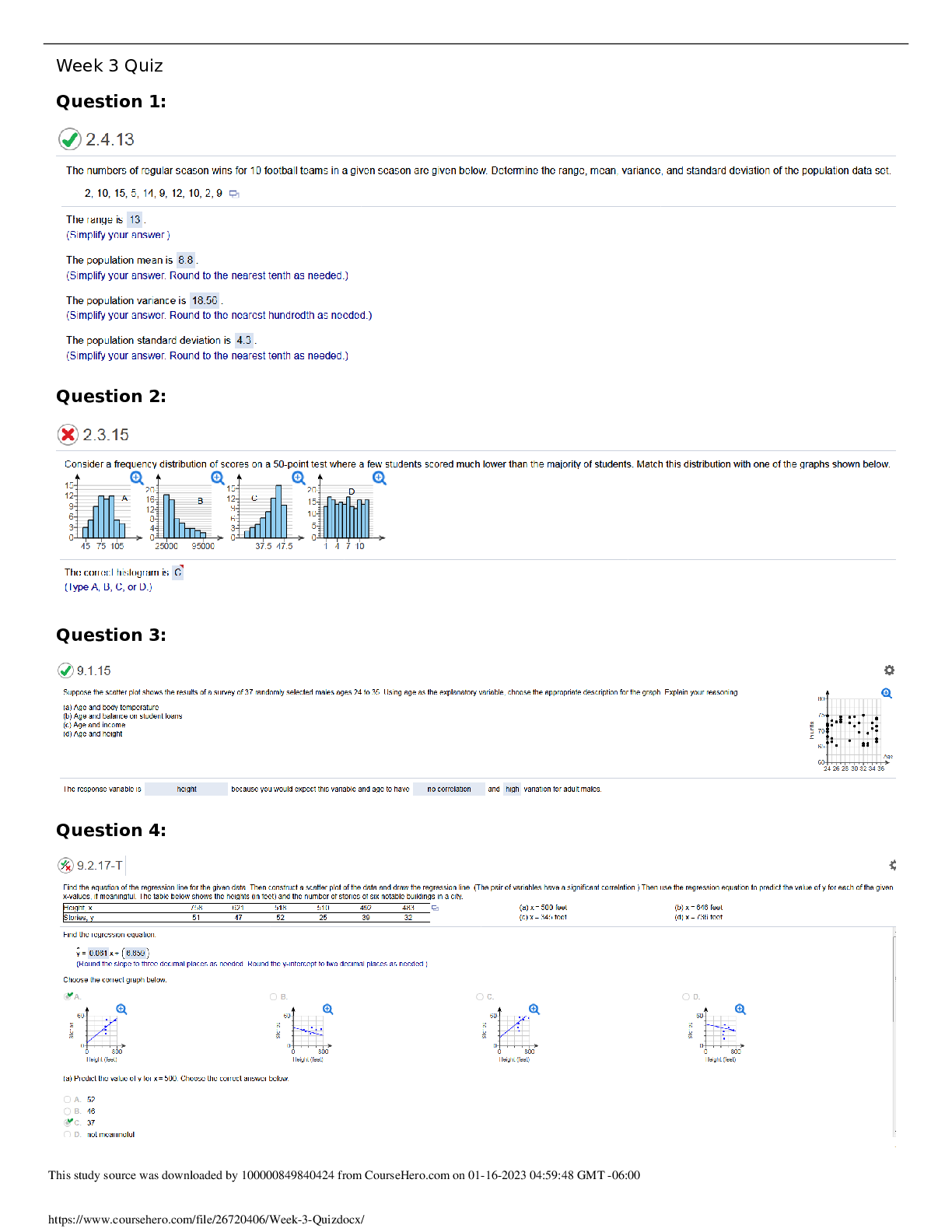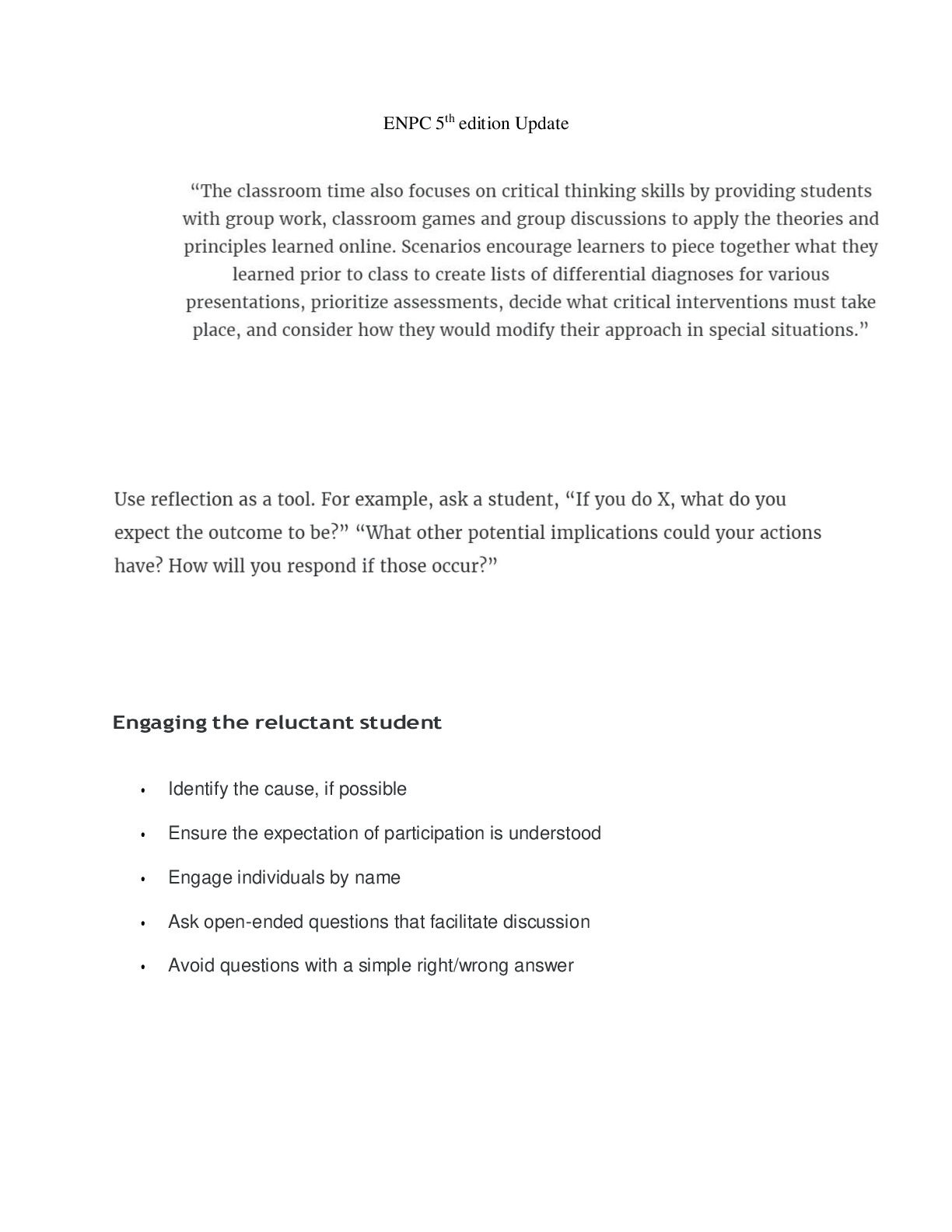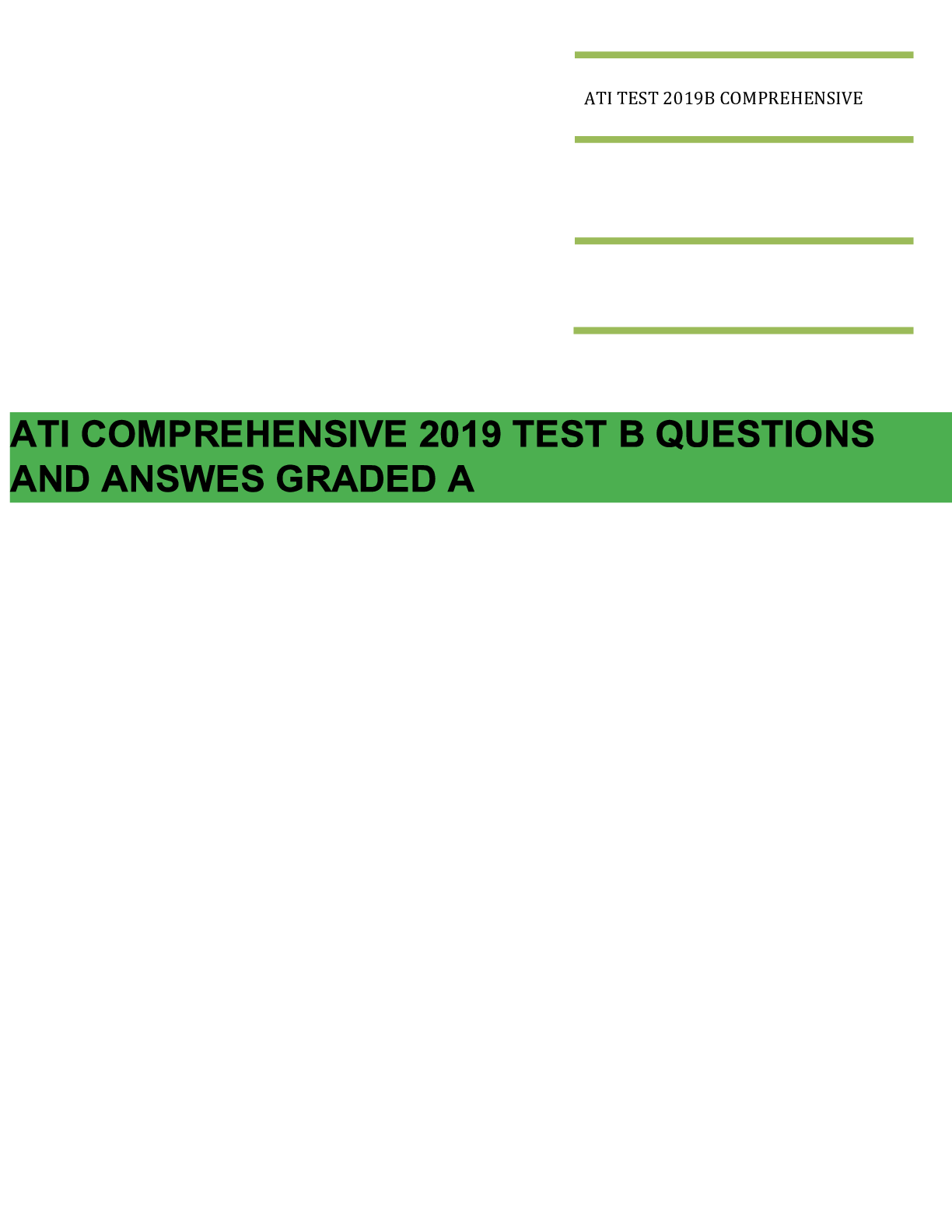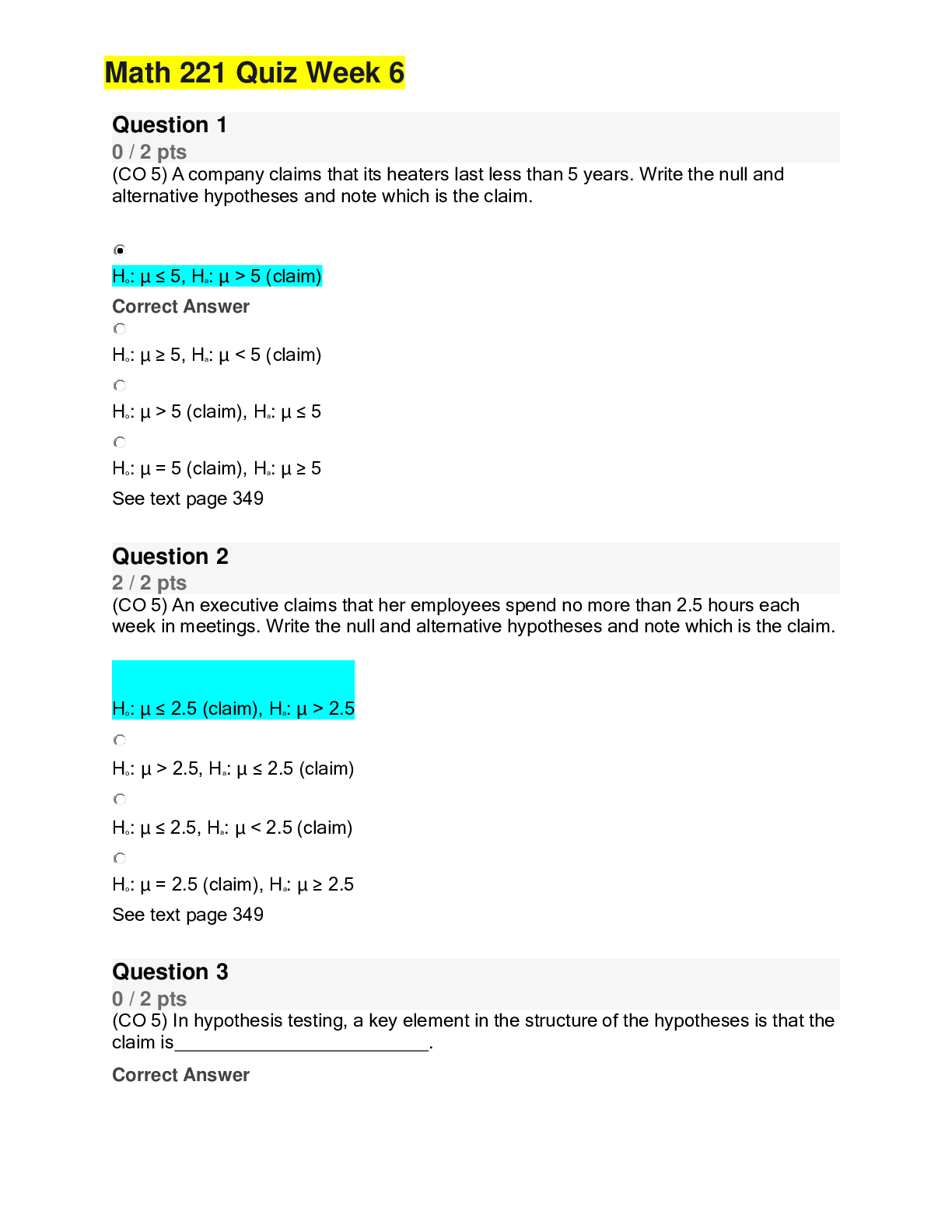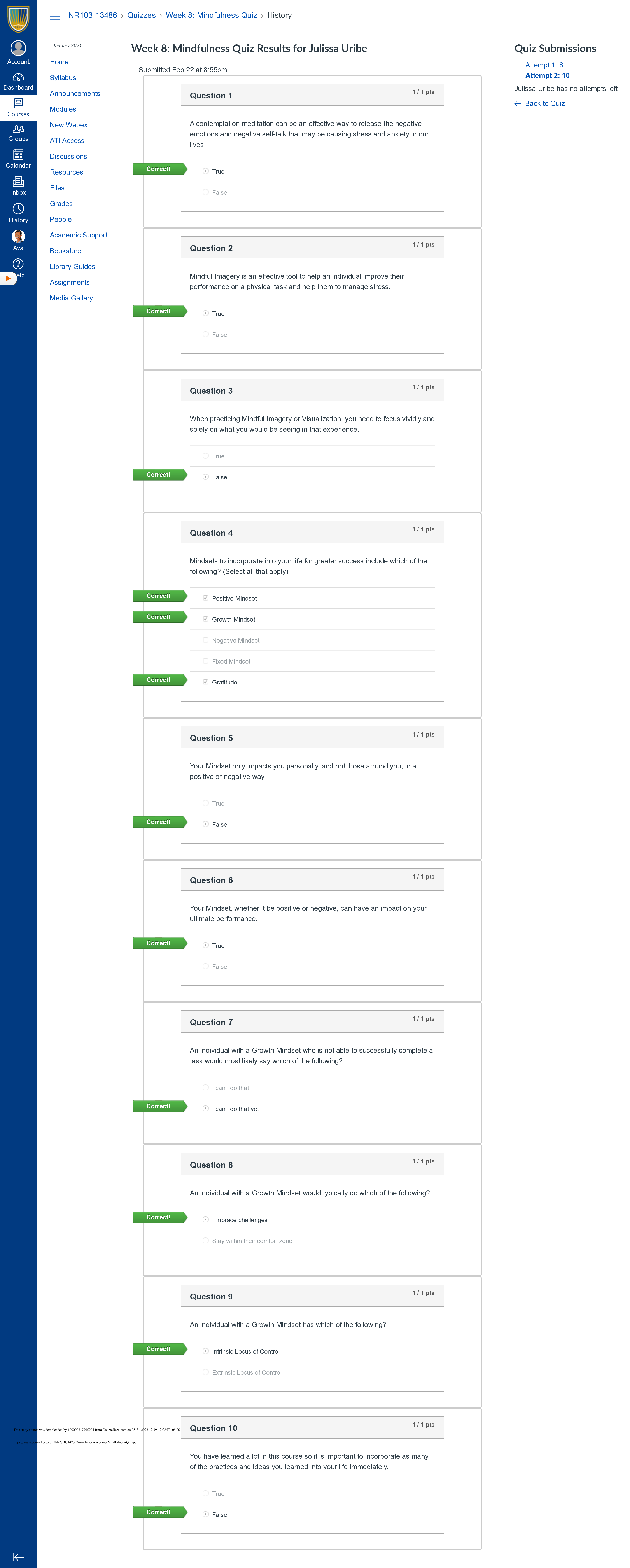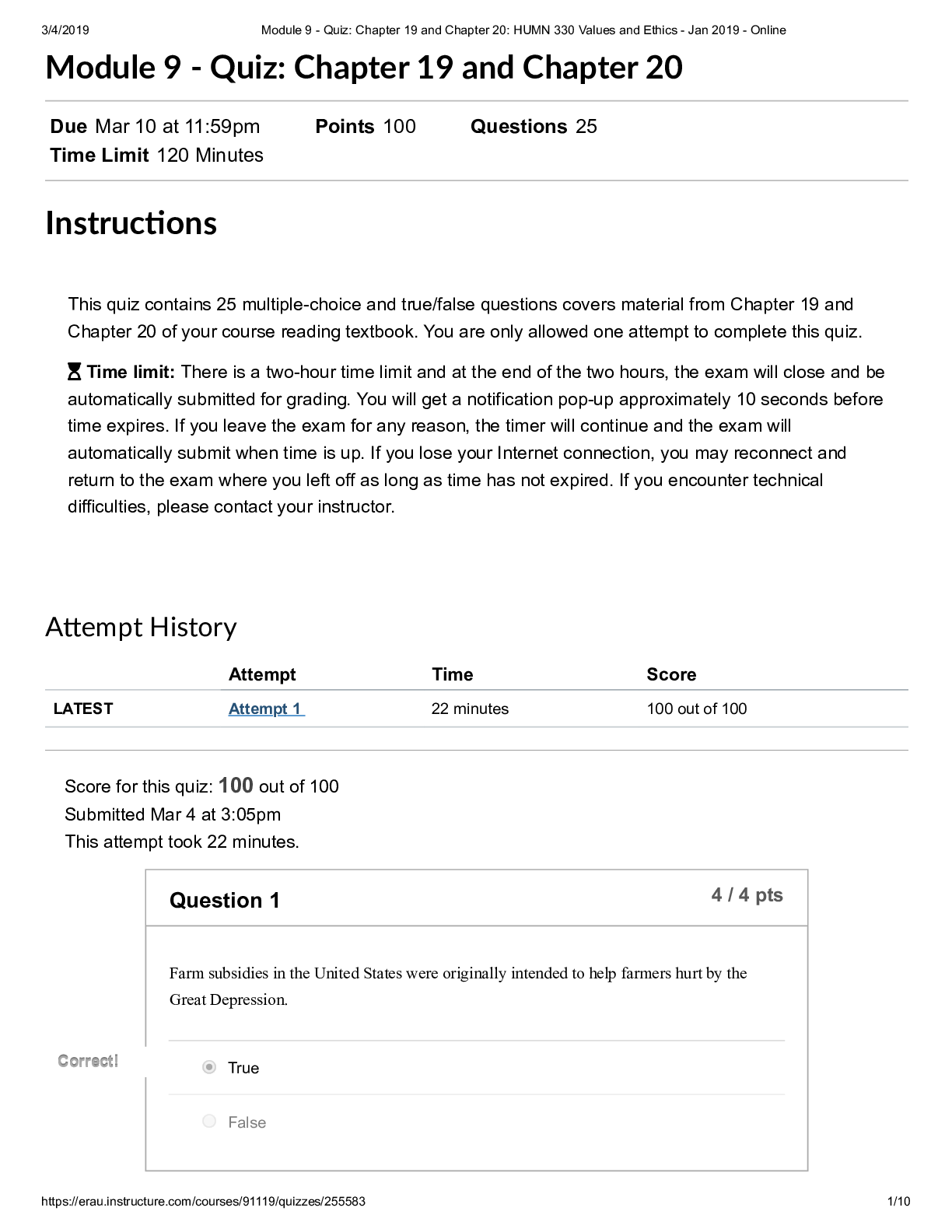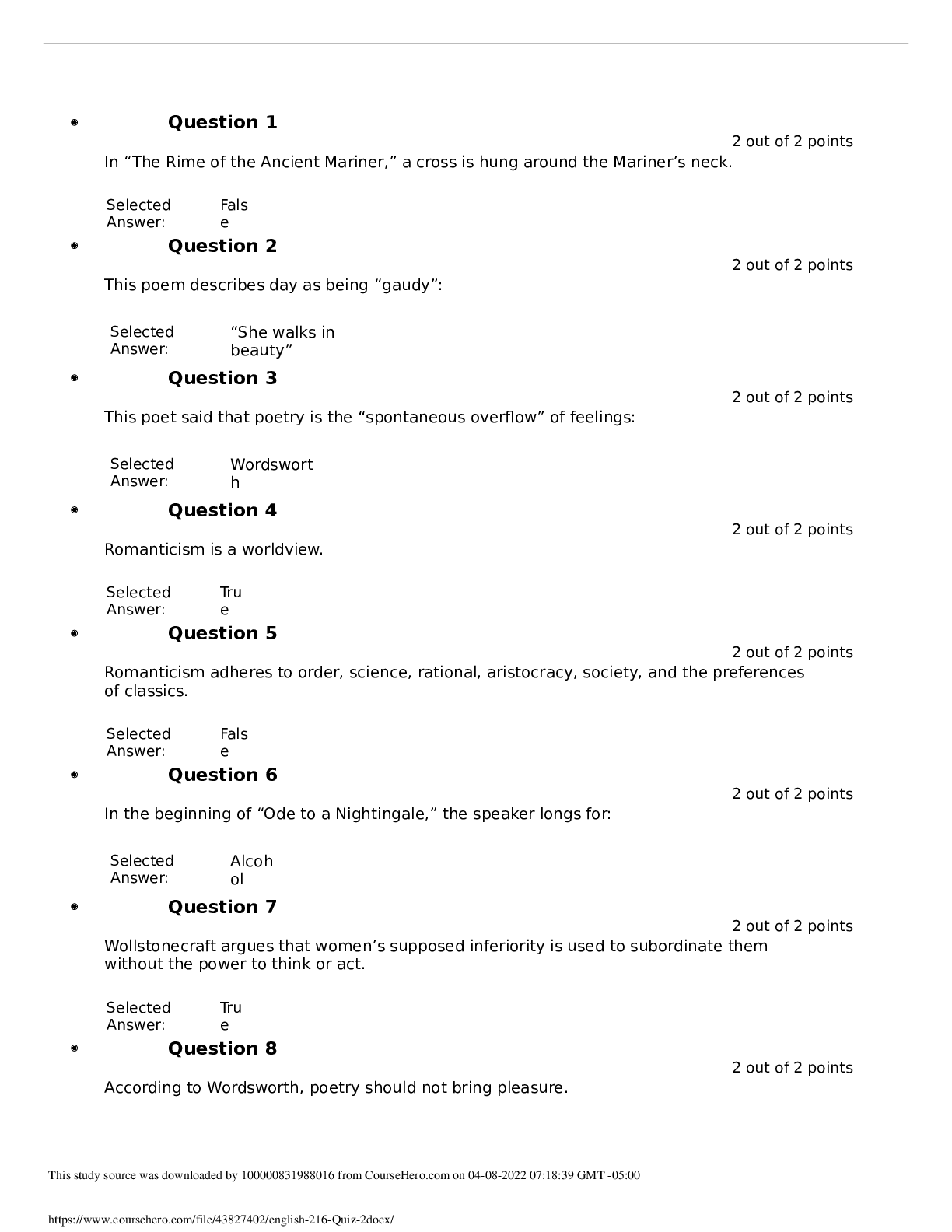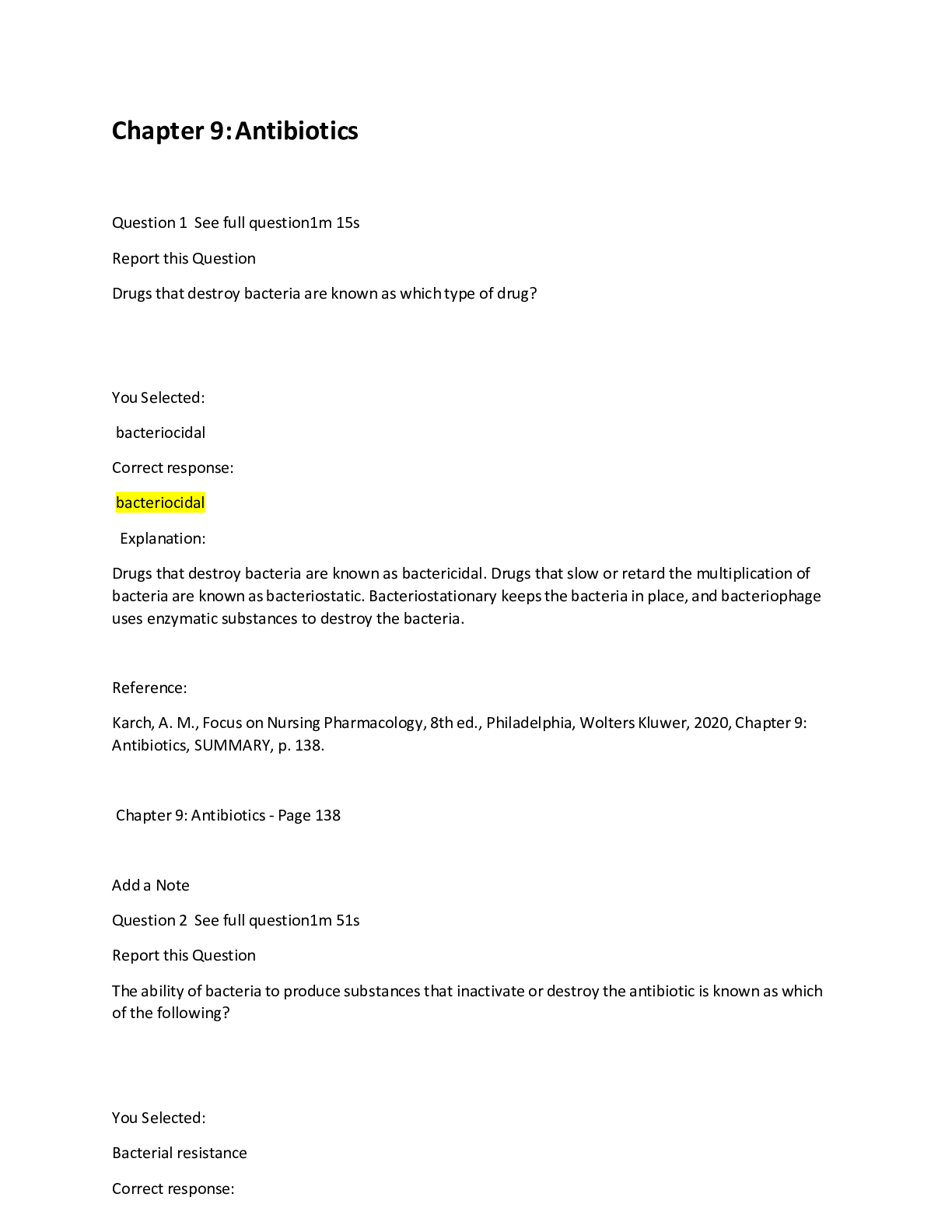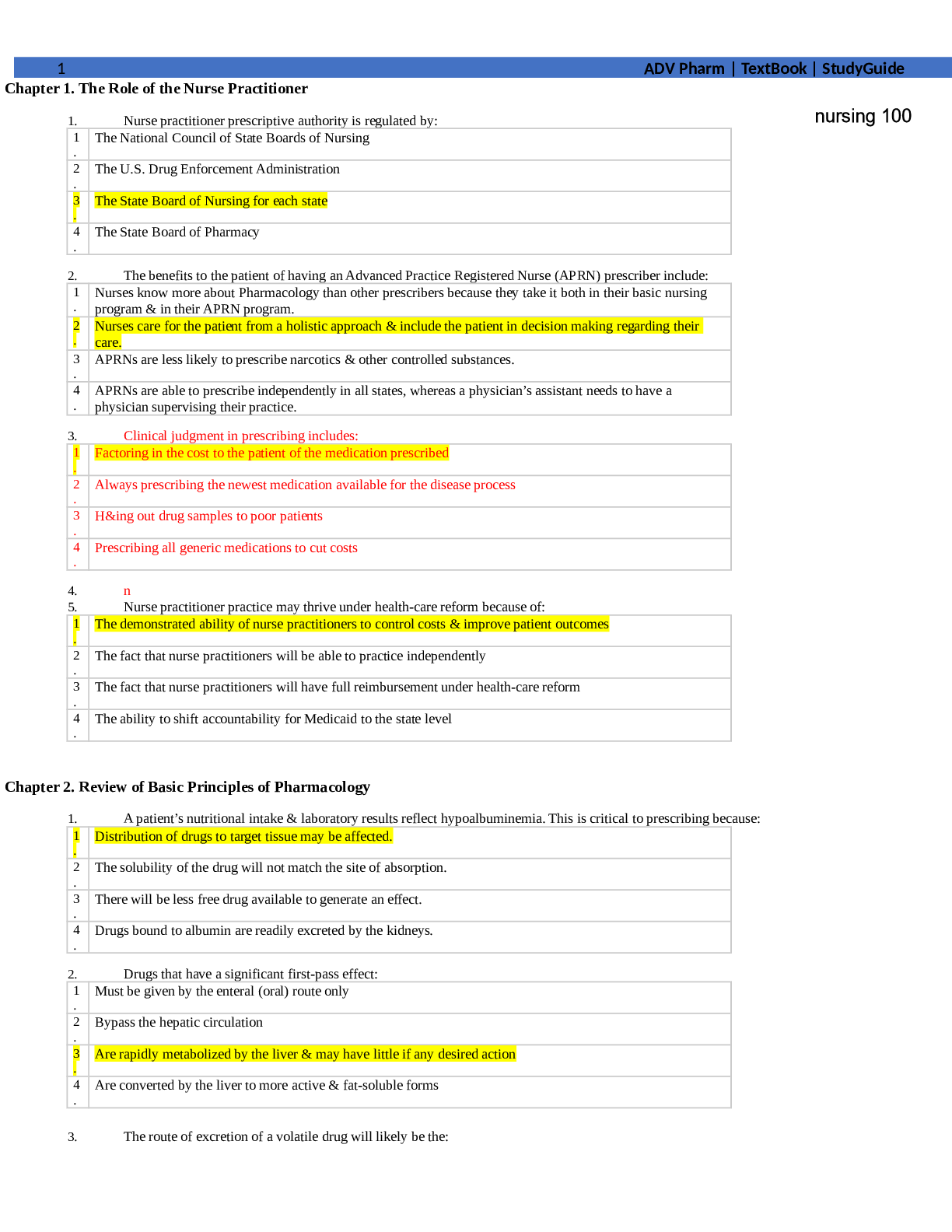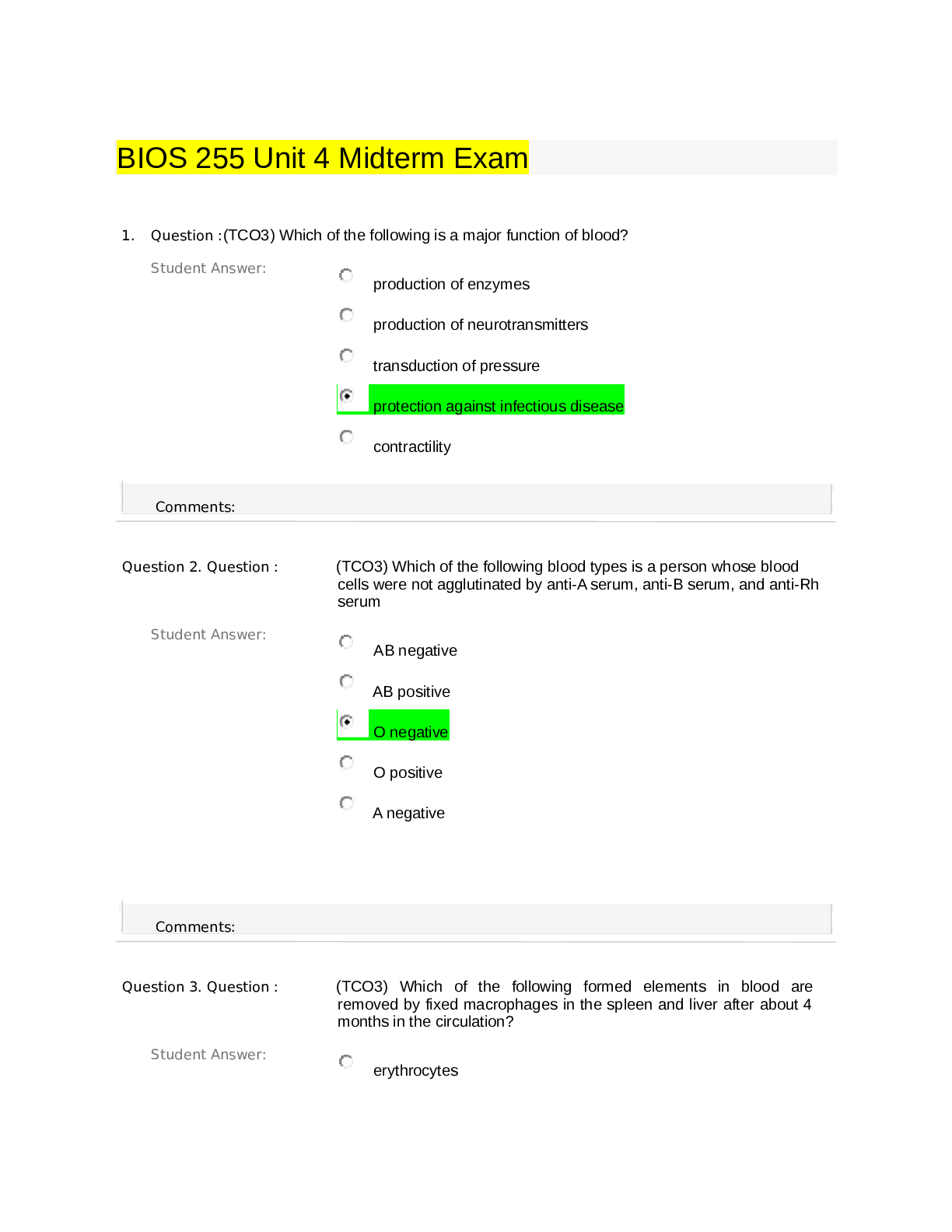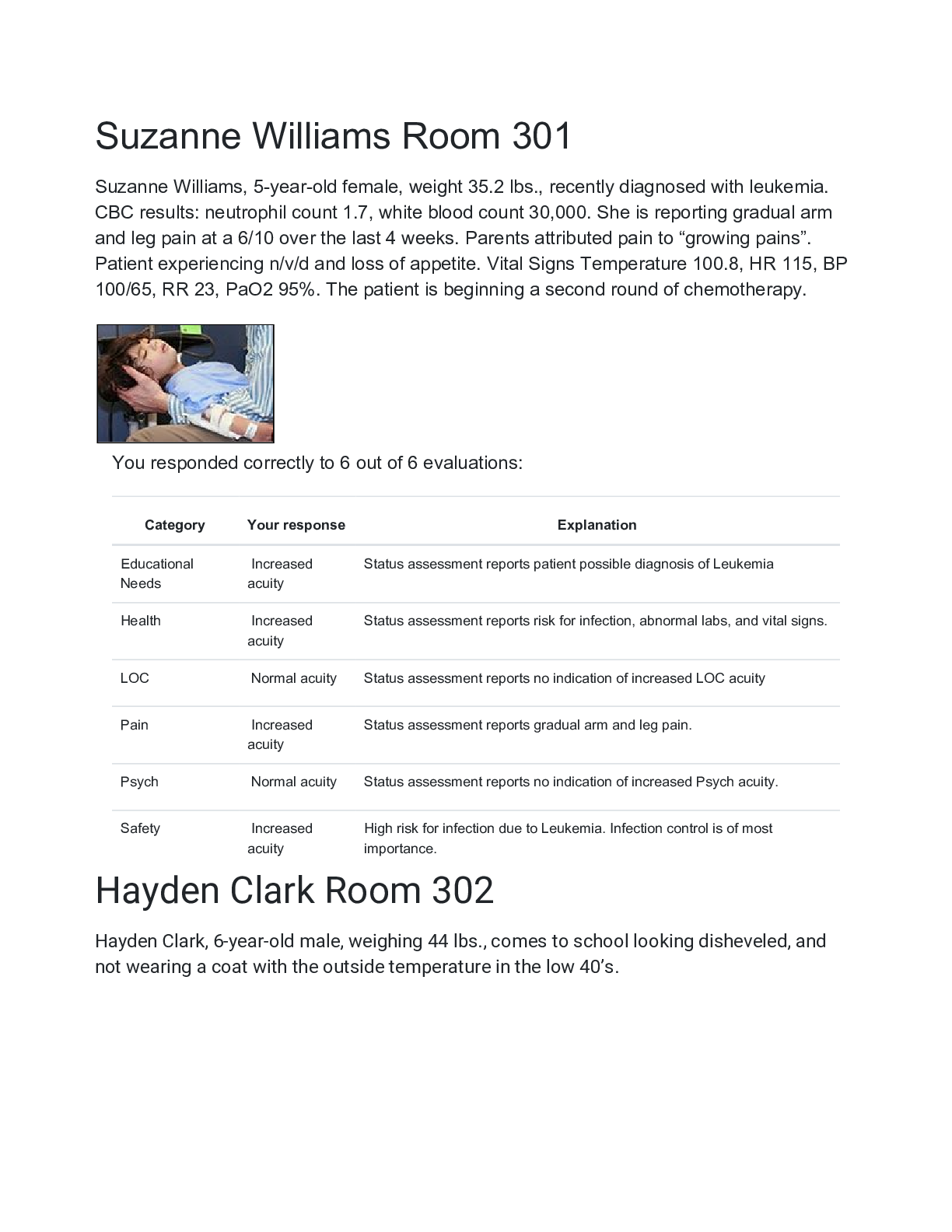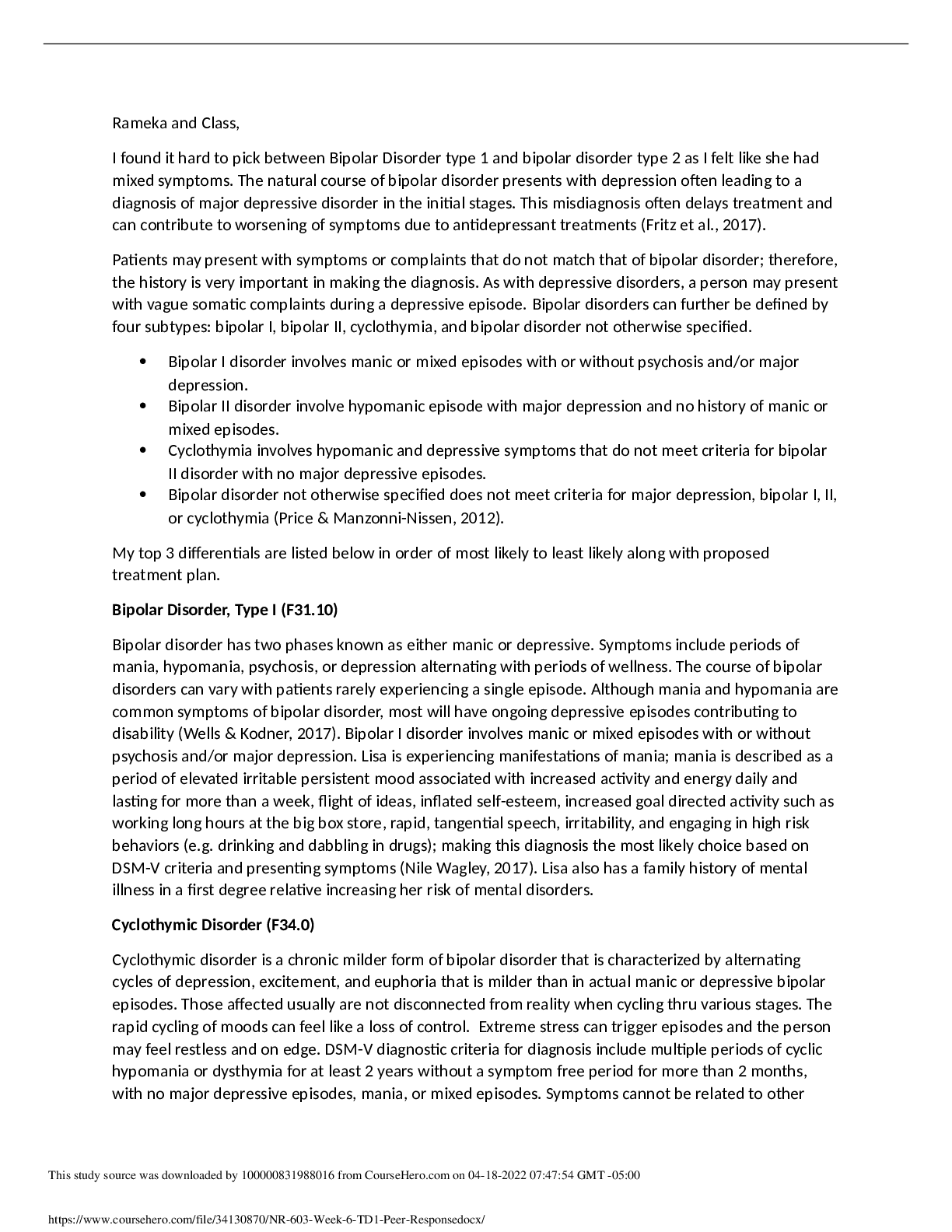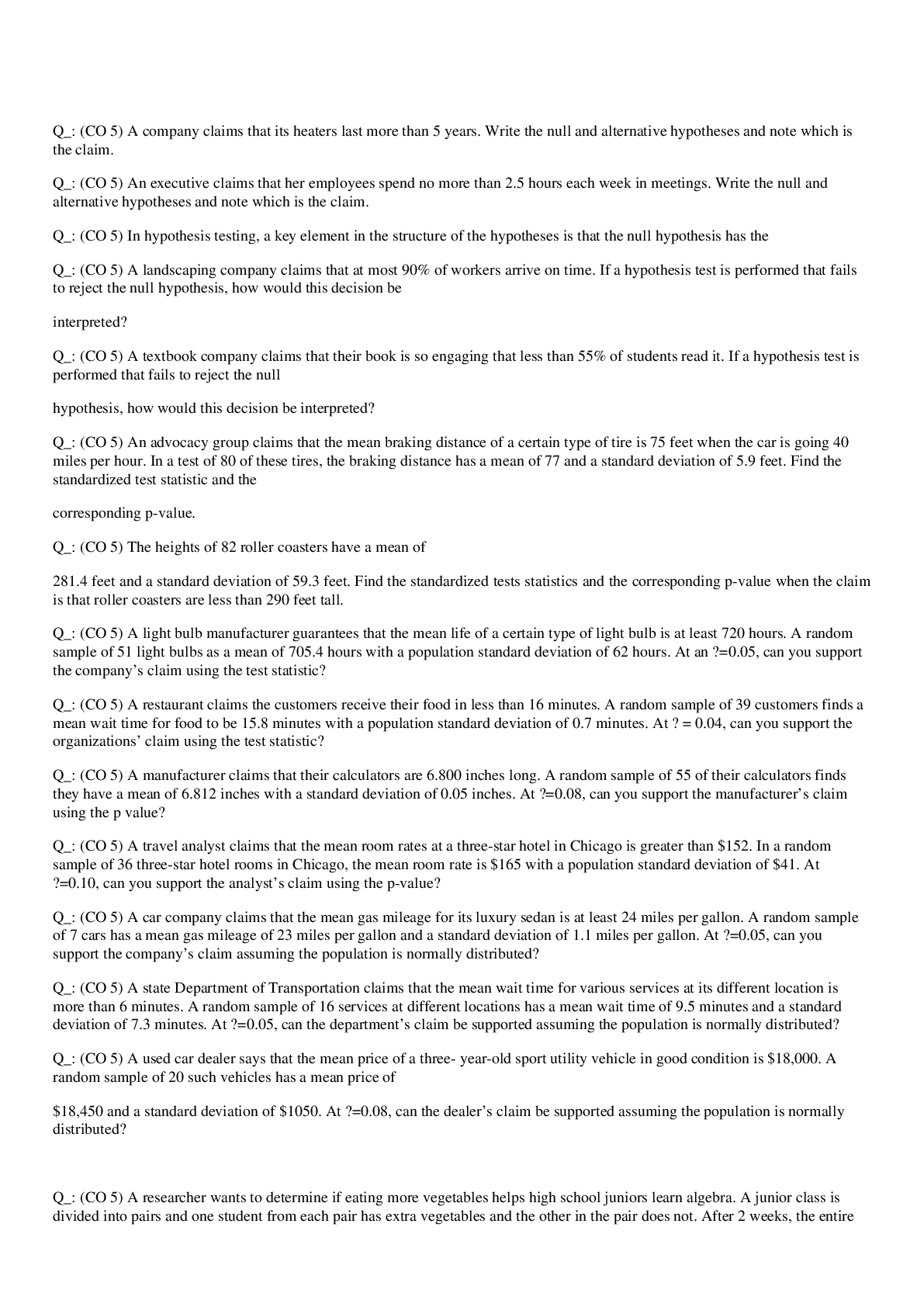PEDS FINAL EXAM (250 Questions) | GRADED A. Download For Best EXAM Results.
Document Content and Description Below
PEDS FINAL PROCTORED EXAM (250 Questions) | GRADED A. Download For Best EXAM Results. Chapter 12 Neuro disorders 1. A nurse is caring for a client who has suspected meningitis and a decreased leve... l of consciousness. Which of the following actions by the nurse is appropriate? A. Place the client on NPO status. 2. A nurse is caring for a 4-month-old infant who has meningitis. Which of the following findings is associated with this diagnosis? D. High-pitched cry 3. A nurse is reviewing cerebrospinal fluid analysis for a client who has suspected meningitis. Which of the following results indicate viral meningitis? (Select all that apply.) A. Negative gram stain B. Normal glucose content E. Normal protein content 4. A nurse is developing an in-service about viral and bacterial meningitis. The nurse should include that the introduction of which of the following immunizations decreased the incidence of bacterial meningitis in children? (Select all that apply.) B. Pneumococcal conjugate vaccine (PCV) D. Haemophilus influenzae type B (Hib) vaccine 5. A nurse is caring for a school-age client who possibly has Reye syndrome. Which of the following is a risk factor for developing Reye syndrome? C. Recent episode of gastroenteritis Chapter 13 seizures 1. A nurse is caring for a child who has absence seizures. Which of the following findings can the nurse expect? (Select all that apply.) A. Loss of consciousness B. Appearance of daydreaming C. Dropping held objects A B C 2. A nurse is caring for a child who just experienced a generalized seizure. Which of the following is the priority action for the nurse to take? A. Maintain in a side-lying position. 3. A nurse is providing teaching to the parent of a child who is to have an electroencephalogram (EEG). Which of the following should be included in the teaching? A. "Decaffeinated beverages should offered on the morning of the procedure." 4. A nurse is teaching a group of parents about the risk factors for seizures. Which of the following should be included in the teaching? (Select all that apply.) A. Febrile episodes B. Hypoglycemia C. Sodium imbalances 5. A nurse is reviewing treatment options with the parent of a child who has worsening seizures. Which of the following should be included in the discussion? (Select all that apply.) A. Vagal nerve stimulator B. Additional antiepileptic medications C. Corpus callosotomy D. Focal resection Chapter 14 Head Injury 1. A nurse is caring for a child who was admitted to the emergency department after a motor-vehicle crash. The child is unresponsive, has spontaneous respirations of 22/min, and has a laceration on the forehead that is bleeding. Which of the following is the priority nursing action at this time? A. Stabilize the child’s neck. 2. A nurse is caring for an adolescent who has sustained a closed head injury. Which of the following are clinical manifestations of increased intracranial pressure (ICP)? (Select all that apply.) A. Report of headache B. Alteration in pupillary response D. Increased sleeping 3. A nurse is caring for a child who has increased intracranial pressure. Which of the following are appropriate actions by the nurse? (Select all that apply.) B. Maintain a quiet environment. D. Administer a stool softener. E. Maintain body alignment 4. A nurse is assessing a child who has a concussion. Which of the following findings should the nurse expect? (Select all that apply.) A. Amnesia C. Bradycardia D. Respiratory depression E. Confusion 5. A nurse is teaching a parent about dexamethasone (Decadron) to treat head injury. Which of the following should be included in the teaching? A. "It decreases cerebral edema." 6. A nurse is caring for a child who is taking Mannitol for cerebral edema. Adverse effect to report to the provider? C. Confusion Chapter 15 Cognitive and Sensory Impairments 1. A nurse is planning to perform a peripheral vision test on a child. Which of the following is an appropriate action for the nurse to take? D. Have the child focus on an object while performing the test. **A nurse is teaching a group of parents about possible manifestations of Down syndrome. Which of the follows should the nurse include in the teaching? (Select all that apply) C. Protruding abdomen D. Broad short feet and hands E. Hypotonia 2. A nurse is teaching the parent of a child who has strabismus. Which of the following should be included in the teaching? C. "Placing a patch over the strong eye is needed." 3. A nurse is assessing a child who has myopia. Which of the following are clinical manifestations of myopia? (Select all that apply.) A. Headaches C. Difficult reading E. Poor school performance **A nurse is teaching the parent of an infant who has Down syndrome. Which of the following statements indicates an understanding of the teaching. B. “I should place a cool mist humidifier in his room” 4. A nurse is assessing a toddler for possible hearing loss. Which of the following are clinical manifestations of a hearing impairment? (Select all that apply.) A. Uses monotone speech B. Speaks loudly D. Appears shy 5. A nurse is completing a physical assessment of a child with suspected glaucoma. Which of the following findings confirm this diagnosis? (Select all that apply.) A. Epiphora D. Blepharospasm E. Report of pain Chapter 27 Fractures 1. A nurse is caring for a child who is in a plaster spica cast. Which of the following is an appropriate action for the nurse to take? D. Apply moleskin to the edges of the cast. 2. A nurse is teaching a group of parent about fractures. Which of the following should be included in the teaching? B. "Epiphyseal plate injuries may result in altered bone growth." 3. A nurse is caring for a child who sustained a fracture. Which of the following are appropriate actions for the nurse to take? (Select all that apply.) B. Elevate the affected limb. C. Assess neurovascular status frequently. E. Stabilize the injury. 4. A nurse is caring for a child who has a fracture. Which of the following are clinical manifestations of a fracture? (Select all that apply.) A. Crepitus B. Edema C. Pain E. Ecchymosis 5. A nurse is caring for a child who is in Russell traction. Which of the following are appropriate actions for the nurse to take? (Select all that apply.) B. Assess the child's position frequently. C. Assess pin sites every 4 hr. D. Ensure the weights are hanging freely. Chapter 28 1. A nurse is caring for a toddler who is diagnosed with hip dysplasia and has been placed in a hip spica cast. The child's mother asks the nurse why a Pavlik harness is not being used. Which of the following responses by the nurse appropriately addresses the mother's question? D. "The Pavlik harness is used for infants less than 6 months of age." 2. A nurse is completing preoperative teaching with an adolescent client who is going to receive spinal instrumentation for scoliosis. Which of the following information should the nurse include in the teaching? C. "You will need to receive blood." 3. A nurse is assessing a child. Which of the following are clinical manifestations of Legg-Calve-Perthes disease? (Select all that apply.) B. Hip stiffness D. Limited ROM E. Limp with walking 4. A nurse is caring for a preschool-age child. Which of the following assessments should the nurse use to assess for developmental dysplasia of the hip? B. Trendelenburg sign 5. A nurse is caring for a child. Which of the following diagnostic procedure should the nurse prepare the child for to determine if the child has Legg-Calve-Perthes disease? D. Radiographs Chapter 29 1. A nurse is caring for a child who has cerebral palsy. Which of the following medications should the nurse expect to administer to treat painful muscle spasms? (Select all that apply.) A. Baclofen (Lioresal) B. Diazepam (Valium) 2. A nurse is caring for a school-age child who has juvenile idiopathic arthritis. Which of the following are appropriate home care instructions? (Select all that apply.) A. provide extra tie for completion of ADL’s. E. Perform range-of-motion exercises. 3. A nurse is teaching a group of parents about possible manifestations of Down syndrome. Which of the following should she include in the teaching? (Select all that apply.) C. Protruding abdomen D. Broad, short feet and hands E. Hypotonia 4. A nurse is caring for a child who has muscular dystrophy. For which of the following findings should the nurse assess? (Select all that apply.) C. Muscular weakness in lower extremities D. Unsteady, wide-based or waddling gait 5. A nurse is caring for an infant who has a myelomeningocele. Which of the following should she include in the plan of care? D. Apply a moist dressing on the sac. **A nurse is developing a plan of care for a toddler who has cerebral palsy. Which of the following actions should the nurse include? B. Evaluate the toddlers need for an evaluation of hearing ability. Chapter 43 A nurse is caring for a child who is experiencing respiratory distress. Which of the following findings are early manifestations of respiratory distress? (Select all that apply.) C. tachycardia D. diaphoresis E. restlessness A nurse in the emergency department is caring for a child whose parent reports that the child has swallowed paint thinner. The child is lethargic, gagging, and cyanotic. Which of the following actions should the nurse take? C. Prepare for intubation with a cuffed endotracheal tube. A nurse in the emergency department is admitting an infant who experienced a life-threatening event. Which of the following prescriptions by the provider should the nurse anticipate? (Select all that apply.) A. electroencephalogram B. electrocardiogram E. Blood culture A nurse is providing teaching to a parent about acetaminophen poisoning. Which of the following information should the nurse include in the teaching? B. Pallor can appear as early as 2 hr. after ingestion. A nurse in a community center is providing an in-service to a group of parents on management of airway obstructions in toddlers. Which of the following responses by the parents indicates understanding? (Select all that apply.) A."I will push on my child's abdomen." C."I will listen over my child's mouth for sounds of breathing." D."I will use my finger to check my child's mouth for objects." Chapter 44 Psychological issues of infants, children, and adolescents 1. A nurse is teaching a group of parents about infants who have failure to thrive. Which of the following Characteristics should be included in the teaching? D. They exhibit developmental delays. 2. A nurse is providing instruction to the teacher of a child who has attention-deficit/hyperactivity disorder (ADHD). Which of the following classroom strategies should be included in the teaching? (Select all that apply.) B. Allow for regular breaks. C. Combine verbal instruction with visual cues. D. Establish consistent classroom rules. E. Decrease stimuli in the environment. 3. A nurse is teaching a parent about posttraumatic stress disorder (PTSD). Which of the following should be included in the teaching? (Select all that apply.) A. Children who have PTSD require psychotherapy. B. A clinical manifestation of PTSD is phobias. D. PTSD develops following a traumatic event. E. There are six stages of PTSD. 4. A nurse is providing teaching to the parent of a child who has attention-deficit/hyperactivity disorder. The nurse should include which of the following as a characteristic of impulsivity? B. Frequently interrupts 5. A nurse is caring for a child who has depression. Which of the following findings are associated with this diagnosis? (Select all that apply.) A. Prefers being with peers C. Report of low self-esteem D. Sleeping more than usual Nursing care child 1 3.0 (40) A nurse is caring for an 18-year-old adolescent who is up-to-date on immunizations and is planning to attend college. The nurse should inform the client that he should receive which of the following immunizations prior to moving into a campus dormitory? B. Meningococcal polysaccharide A nurse is assessing a 9-month-old infant during a well-child visit. Which of the following findings indicates that the infant has a developmental delay? B. Inability to vocalize vowel sounds A nurse is caring for a preschool-age child who is dying. Which of the following findings is an age- appropriate reaction to death by the child? (Select all that apply.) D. The child believes his thoughts can cause death. E. The child thinks death is a punishment. A nurse is caring for an adolescent who is receiving pain medication via a PCA pump. When the nurse assesses the client's pain at 0800, the client describes the pain as a 3 on a scale of 1 to 10. At 1000, the client describes the pain as a 5. The nurse discovers the client has not pushed the button to deliver medication in the past 2 hr. Which of the following actions should the nurse take? D. Reinforce teaching with the client about how to push the button to deliver the medication. A nurse in a pediatric clinic is assessing a toddler at a well-child visit. Which of the following actions should the nurse take? B. Minimize physical contact with the child initially. A nurse on a pediatric unit is admitting a 4-year-old child. Which of the following toys should the nurse plan to provide for the child to engage in independent play? B. Plastic stethoscope A nurse is caring for a 2-year-old child who has cystic fibrosis. The nurse is planning to take the child to the playroom. Which of the following activities would be appropriate for the child? D. Building towers of blocks A nurse is providing anticipatory guidance about accidental ingestion of a toxic substance to the parents of a toddler. The nurse should instruct the parents to take which of the following actions first if the child ingests a hazardous substance? C. Call the poison control center. A nurse in a pediatric clinic is caring for a 3-year-old child who has a blood lead level of 3 mcg/dL. When teaching the toddler's parent about the correlation of nutrition with lead poisoning, which of the following information is appropriate for the nurse to include in the teaching? D. Ensure the child's dietary intake of calcium and iron is adequate. A nurse is planning care for a 10-month-old infant who has suspected failure to thrive (FTT). Which of the following interventions should the nurse include in the plan of care? (Select all that apply.) A. Observe the parents' actions when feeding the child. B. Maintain a detailed record of food and fluid intake. A nurse in the emergency department is caring for a 2-year-old child who was found by his parents crying and holding a container of toilet bowl cleaner. The child's lips are edematous and inflamed, and he is drooling. Which of the following is the priority action by the nurse? B. Check the child's respiratory status. A nurse is providing education to the parent of a toddler who is about to receive her first dose of the MMR (measles, mumps and rubella) immunization. Which of the following statements by the parent indicates an understanding of the teaching? C. "I can give my child acetaminophen for discomfort associated with the immunization." A nurse is teaching the parent of a 12-month-old infant about nutrition. Which of the following statements by the parent indicates a need for further teaching? D. "My infant drinks at least 2 quarts of skim milk each day." A nurse is assisting a provider during a femoral venipuncture on a toddler. The nurse should place the child in which of the following positions? D. Supine A nurse providing teaching about promoting sleep with the parent of a 3-year-old toddler. Which of the following information should the nurse include? A. Follow a nightly routine and established bedtime. A nurse is assessing a 3-year-old child who is 1 day postoperative following a tonsillectomy. Which of the following methods should the nurse use to determine if the child is experiencing pain? B. Use the FACES scale. A nurse is teaching the parent of an infant about food allergens. Which of the following foods should the nurse include as being the most common food allergy in children? A. Cow's milk A nurse is preparing to administer recommended immunizations to a 2-month-old infant. Which of the following immunizations should the nurse plan to administer? C. Haemophilus influenzae type B (Hib) and inactivated polio virus (IPV) A nurse is teaching the parent of an infant about home safety. Which of the following information should the nurse include? (Select all that apply.) C. Position the car seat so it is rear-facing. D. Secure a safety gate at the top and bottom of the stairs. E. Maintain the water heater temperature at 49° C (120° F). A nurse is preparing to administer a liquid medication to an infant. Which of the following actions should the nurse take? B. Give the medication at the side of the infant's mouth. A nurse in an emergency department is caring for an 8-year old who is up-to-date with current immunization recommendations and has a deep puncture injury. Which of the following should the nurse anticipate administering? D. Adult tetanus booster (Td) A nurse is observing a mother who is playing peek-a-boo with her 8-month-old child. The mother asks if this game has any developmental significance. The nurse should inform the mother that peek-a-boo helps develop which of the following concepts in the child? C. Object permanence A nurse is performing a physical assessment on a 6-month-old infant. Which of the following reflexes should the nurse expect to find? B. Babinski A nurse is planning to collect a specimen from a male infant using a urine collection bag. Which of the following actions should the nurse take? A. Wash and dry the infant's genitalia and perineum thoroughly. A nurse is providing teaching to the parents of a 4-year-old child about fine motor development. Which of the following tasks should the nurse include in the teaching as an expected finding for this age group? A. Copies a circle A nurse is caring for a toddler and is preparing to administer 0.9% sodium chloride 100 mL IV to infuse over 4 hr. The drop factor of the manual IV tubing is 60 gtt/mL. The nurse should set the manual IV infusion to deliver how many gtt/min? (Round the answer to the nearest whole number. Use a leading zero if it applies. Do not use a trailing zero.) 25 gtt A nurse is caring for a 15-month-old toddler who requires droplet precautions. Which of the following actions should the nurse take? C. Wear a mask when assisting the toddler with meals. A nurse is assessing a 6-month-old infant at a well-child visit. Which of the following findings indicates the need for further assessment? C. Legs remain crossed and extended when supine A nurse on a pediatric unit is reviewing the health record of a client who is demonstrating increasing levels of stress after admission. The nurse should identify which of the following findings as a risk factor for a stress-related reaction to hospitalization? C. Male gender A nurse is teaching a parent of a 12-month old child about development during the toddler years. Which of the following statements should the nurse include? D. "Your child should be able to scribble spontaneously using a crayon at the age of 15 months." A nurse is developing a plan of care for a school-age child who underwent a surgical procedure that resulted in a temporary loss of vision. Which of the following interventions should the nurse include in the plan of care? B. Explain sounds the child is hearing. A nurse is caring for a child who has bacterial endocarditis. The child is scheduled to receive moderate term antibiotic therapy and requires a peripherally inserted central catheter (PICC). Which of the following statements should the nurse include when teaching the child's parent? A. "The PICC line will last several weeks with proper care." A nurse in the emergency department is caring for a 12-year-old child who has ingested bleach. Which of the following statements by the nurse indicates an understanding of this ingestion? C. "Injury by a corrosive liquid is more extensive than by a corrosive solid." A nurse is assessing a 6-year-old child at a well-child visit. Which of the following findings requires further assessment by the nurse? A. Presence of sparse, fine pubic hair A nurse at a pediatric clinic is assessing a 5-month-old infant during a well-child visit. Which of the following findings should the nurse report to the provider? A. Head lags when pulled from a lying to a sitting position A nurse is assessing a 30-month-old toddler during a well-child visit. Which of the following findings requires further assessment by the nurse? C. Birth weight is tripled A nurse is assessing a 12-month-old male infant's vital signs during a well-child visit. The infant is in the 90th percentile of height. Which of the following findings should the nurse report to the provider? A. Heart rate 175/min A nurse is teaching the parent of a toddler about home safety. Which of the following statements by the parent indicates an understanding of the teaching? A. "I lock my medications in the medicine cabinet." A nurse is planning to implement relaxation strategies with a young child prior to a painful procedure. Which of the following actions should the nurse take? D. Rock the child in long rhythmic movements. A nurse is assessing a 7-year-old child's psychosocial development. Which of the following findings should the nurse recognize as requiring further evaluation? C. The child complains daily about going to school. Nursing care of child 2 A nurse is educating a parent on the treatment for pinworms. Which of the following statements by the parent indicate that teaching has been effective? "I will give my child mebendazole (Vermox) today and in two weeks." A nurse is assessing a 4-year-old child at a well-child appointment. The parent expresses concern over the child's stuttering. The nurse provides teaching to the parent. Which of the following statements by the parent indicates a need for further teaching? "It may help if you encourage your child to stop and begin the word over." A nurse is caring for a child who is diagnosed with Wilms' tumor. Which of the following interventions should the nurse do first? Place a sign over the bed that says "Do Not Palpate the Abdomen". A nurse is caring for a child with dehydration. Which of the following should the nurse recognize as an appropriate assessment to determine the child's response to parenteral fluids? Weighing the child at the same time every day A nurse is caring for an 8-year-old child who has acute glomerulonephritis. Which of the following should the nurse expect to find with this client? Elevated red blood cells A nurse is caring for a child who has had a spinal fusion. Which of the following statements by the nurse indicates an understanding of the care of this client? "I'll log roll the client every 2 hr." A nurse is caring for a 3-year-old child who is in need of a hypospadias repair. Which of the following should the nurse recognize as a concern to this age group? Damage to body integrity A nurse is caring for a child with bronchiolitis. Assessment findings indicate wheezing, oxygen saturation of 100%, respiratory rate of 40/min, and a heart rate of 92/min. The child is receiving oxygen at 2 LPM. An order is written to wean oxygen maintaining oxygen saturation 95% or greater. Which of the following actions is most appropriate for the nurse to take? Lower the oxygen to 1 L/min, check the oxygen saturation, and reassess the child. A nurse is caring for a 4 year old child who has a malfunctioning ventriculo peritoneal shunt. Following a new shunt placement, the nurse conducts a postoperative check. Which of the following assessments should the nurse immediately respond to? Sleepy, very difficult to arouse A nurse is caring for a 6 year old child who is newly diagnosed with diabetes mellitus. The nurse is educating the child on how to do finger sticks for blood glucose checks. The nurse knows the most effective method to teach this skill will be to do which of the following? Allow the child to practice the skill on themselves or others. A nurse is caring for an adolescent with diabetes mellitus who has been admitted twice this year to the hospital with diabetic ketoacidosis. Which of the following tests should the nurse recognize as the best information to evaluate the client's compliance? Hemoglobin A1C A nurse observes an adolescent with celiac disease ordering a gluten free breakfast tray. The nurse should know that the client understands the diet when the client orders which of the following items? Eggs and orange juice A nurse is caring for a child diagnosed with sickle cell anemia. The nurse should make which of the following recommendations to the client regarding sickle cell anemia? Increase fluid intake. A nurse is caring for a preschooler diagnosed with human immunodeficiency virus who is at the clinic to receive immunizations. Which of the following statements about HIV immunizations for this child is the most appropriate? The only immunization contraindicated for this client is the oral polio. A nurse is caring for a 4-year-old who is brought into the emergency room with burns to the neck and face following a house fire. Which of the following assessments should the nurse prioritize for this child at this time? Breathing pattern A nurse is caring for a 2 month old infant with a ventricular septal defect. Which of the following observations should indicate to the nurse that the child's condition is worsening? Weight gain of 275 g A nurse is caring for a newborn with a myelomeningocele. In planning care for the newborn, the nurse should be aware that postoperatively, the child is most prone to developing which of the following? Hydrocephalus A nurse is caring for a child who has had a tonsillectomy. Which of the following findings should the nurse give the most attention to 8 hr after surgery? Frequent swallowing A nurse is caring for an 18-month-old toddler who has been admitted following surgical repair of a cleft palate. Postoperatively, the child complains of thirst. The nurse should provide fluids using which of the following? Cup A nurse is caring for a 4-year-old child with leukemia. The child has undergone chemotherapy and now has a fever, pallor, fatigue, and petechiae. Based on this information, which of the following should the nurse expect to find? Hemoglobin 6 g/dL A nurse is caring for a toddler who is exhibiting acute respiratory distress. Which of the following findings should alert the nurse to the possible diagnosis of epiglottitis? Drooling A nurse is caring for a child diagnosed with nephrotic syndrome who is receiving Predisone (Deltasone). Which of the following should the nurse recognize as a therapeutic response of the medication? Weight drops 500 g A nurse is caring for a child with a history of diarrhea for 24 hr. The primary care provider orders a urine specific gravity. Which of the following values should the nurse expect to see? 1.030 A nurse is providing care to a child with a possible intussusception. The parents of the child ask the nurse how the diagnosis is made. Based on an understanding of the diagnostic evaluation for intussusception, which of the following statements should the nurse use? "A barium enema will be given to visualize the obstruction." A nurse is caring for a child with acute glomerulonephritis and an ASO titer is ordered. The child's parent asks the nurse, "Why does the child need this titer?" Which of the following would be an appropriate response by the nurse? "It will tell us if the child had a recent strep infection." In planning care for a child with severe reactive airway disease, the nurse knows that when chronic steroid use is indicated, inhaled steroids are preferred over oral steroids for which of the following reasons? Oral steroids can slow linear growth in children. A nurse is caring for a newborn infant who is suspected of having a tracheo esophageal fistula (TEF). Which of the following nursing assessments would be consistent with this diagnosis? Copious oral secretions A nurse is caring for a child with a Milwaukee brace for scoliosis. After educating the adolescent, the nurse evaluates the client understands the proper application and use of the brace. Which of the following statements should indicate to the nurse that the adolescent understands the use of the brace? "I can take my brace off for about an hour to shower daily." A nurse is caring for a 2 year old child with vomiting and dehydration. Which of the following assessments should prompt the nurse to contact the primary care provider? Potassium 2.5 mEq/L A nurse is caring for a 2-year-old child who has not received any immunizations. During assessment, the child is noted to have maculopapular rash and fever. The child's parent tells the nurse that the child has been exposed to rubeola. Which of the following assessment findings should the nurse expect? Koplik spot A nurse is caring for a 4 month old infant with otitis media. The nurse is educating the child's parent on how to prevent reoccurrences. Which of the following statements by the parent should the nurse recognize as an understanding of the teaching? "I will make sure my baby is sitting upright when drinking a bottle." A nurse is caring for a child with a ventricular septal defect. Which of the following should the nurse expect to assess in this child? Murmur best heard at the lower left sternal border A nurse is caring for a 6 week old infant who is admitted to the pediatric acute care unit following pyloromyotomy. The nurse should anticipate the feeding schedule 8 hr postoperative will be which of the following? Small, frequent bottle feedings A nurse is caring for a 4 month old infant who is admitted with a ventricular septal defect (VSD) and undergoing a cardiac catheterization. Post catheterization, which of the following manifestations should alert the nurse to a potential complication? Groin dressing with small amount of blood noted A nurse is caring for a child with cystic fibrosis. In planning nutritional care for this child, the nurse should include which of the following actions? Increased protein intake. A nurse is teaching a 12-year-old child how to use a steroid inhaler. The nurse should recognize that the teaching has been effective when the child makes which of the following statements? "I will use this medication every day even if I don't have any manifestations." A nurse is caring for a child receiving chemotherapy. The white blood cell count is 1,200/mm^3. In planning the child's care, the nurse should prepare to do which of the following? Maintain protective isolation and monitor for fever. A nurse is caring for a child in skeletal traction. At the change of shift, the nurse finds the client crying in pain, and the right foot is pale and pulseless. Which of the following should the nurse recognize as the appropriate explanation of this finding? This is a critically abnormal finding, and the primary care provider must be notified immediately. A nurse is caring for an adolescent with a fiberglass cast. When providing education for the adolescent, which of the following should the nurse explain? Place plastic over the cast while bathing. A nurse is caring for a 6-month-old infant who has been diagnosed with thalassemia major. After providing a teaching plan, the nurse should recognize that the parent understands the disease process when the parent states which of the following? "My infant will require frequent transfusions." Final 3.0 A nurse is caring for a child who is receiving treatment for diabetic ketoacidosis and has current blood glucose level of 250mg/dL. Which of the following actions should the nurse take? Administer D5NS by continuous IV infusion A nurse is caring for a child who has epistaxis. Which of the following actions should the nurse take? Apply continuous pressure to the child's nose for at least 10 minutes A nurse is teaching the parents of a 3-year-old who has persistent otitis media about prevention. Which of the following statements by the parents indicates and understanding of the teaching? We should not smoke around our child A nurse is assessing the pain level of a 3-year-old who is postoperative following abdominal surgery. Which of the following pain scales should the nurse use? FACES pain rating scale A nurse is caring for a child who has acute glomerulonephritis. Which of the following actions should the nurse take? Check the child's blood pressure every 4 hours A nurse on the pediatric unit is caring for a group of clients. Which of the following findings should be the nurse's priority? A child who has sickle cell anemia and a urine specific gravity of 1.030 A nurse is caring for a preschool-age child who has mucosal ulceration after receiving chemotherapy. Which of the following actions should the nurse take? Instruct the child to use a soft sponge toothbrush when brushing her teeth A nurse is caring for a group of infants who have congenital heart defects. For which of the following defects should the nurse expect to observe cyanosis? Transposition of great arteries A nurse is teaching a school-age child who has a new diagnosis of T1DM. Which of the following statements should the nurse make? You can use a vial of insulin for up to 30 days A nurse is teaching to a group of parents of adolescents about developmental needs. Which of the following statements by a parent should the nurse investigate further? My child spends 4 hours per day in internet chat rooms A nurse is reviewing the medical record of a 2-month-old infant who has rotavirus. The nurse notes a hemoglobin level of 12g/dL and a hematocrit of 51%. Which of the following statements by the nurse indicates an understanding of the laboratory values? The infant might be dehydrated A school nurse is assessing an adolescent child who returned to school following a case of mononucleosis. The child has a note from his provider excusing him from gym class. Which of the following findings should the nurse identify as the reason for this excusal? Potential for sustaining abdominal trauma A nurse is teaching the parents of a 4-month-old infant who has gastroesophageal reflux. Which of the following statements by the parent indicates an understanding of the teaching? I will add 1 teaspoon of rice cereal per ounce to my baby's formula A nurse is caring for a child who has suspected nephrotic syndrome. Which of the following laboratory values should the nurse expect? Serum cholesterol 700mg/dL A nurse is preparing to administer acetaminophen 240mg PO daily to a child who has a temperature of 38.9 C (102 F). The amount available is acetaminophen oral solution 160mg/5ml. How many ml should the nurse administer per dose? 7.5 ml A nurse is caring for a 6-month-old infant who has intussusception. Which of the following actions should the nurse take? Prepare the child for a barium enema A nurse is caring for a school-age child who has glomerulonephritis. The child has decreased urinary output, a blood pressure of 160/78 mmHg, and is receiving hydralazine. Which of the following lunch choices should the nurse recommend? 3 oz grilled chicken, 1 cup of pear slices, and 120 ml (4oz) of apple juice A nurse is teaching the parents of a child who has rheumatic fever. Which of the following statements by a parent indicates an understanding of the teaching? My child may take aspirin for his joint pain A nurse at a clinic is preparing to administer immunizations to a 5-year-old child. Which of the following immunizations should the nurse plan to give? Diphtheria, tetanus, and pertussis (DTaP) A nurse is caring for a child who has cystic fibrosis and a pulmonary infection. Which of the following finding sis the nurse's priority? Inability to clear secretions A nurse is teaching a parent of an infant who has a colostomy. Which of the following statements by the parent indicates an understanding of the teaching? I need to apply paste to the back of the wafer of my child's appliance A nurse is preparing a school-age child for a tonsillectomy. Which of the following actions should the nurse take? Schedule the child for a preoperative visit to the facility A nurse is teaching a school-age child who is to undergo a bone marrow aspiration. Which of the following statements should the nurse make? I will place a pressure dressing over the area following the procedure A nurse is caring for a 4-year-old child who has superficial partial-thickness burns over 50% of his body. When planning for the nutritional needs of the child, which of the following actions should the nurse plan to take? Supplement the child's feedings with enteral feedings A nurse is caring for a child who has a vesicular rash. The parents of the child ask the nurse what illness can cause this rash for 6 days. The nurse should expect that the child has which of the following conditions? Varicella A nurse is caring for a child who has been in Buck's traction for 2 days. Which of the following actions should the nurse take to prevent complications? Check for pulses in the affected leg every 4 hours A nurse is caring for a child who is in the emergency department after ingestion a bottle of acetaminophen. Which of the following medications should the nurse plan to administer? Acetylcysteine A nurse is preparing to administer an intramuscular injection to a 2-month-old infant. In which of the following sties should the nurse plan to administer the injection? Vastus lateralis A nurse is teaching the parents of an infant who has congenital hypothyroidism. Which of the following statements should the nurse make? Your child will need to take thyroid hormone replacement for her entire life A nurse is teaching a group of parents of toddlers about growth and development. A parent asks, "Why does my child's abdomen stick out?" Which of the following statements should the nurse make? Toddlers don't have well developed abdominal muscles A nurse is caring for a 10-year-old child who should reduce his fat intake. Which of the following menu choices should the nurse suggest? 3 oz of baked chicken on a whole wheat roll A nurse is assessing an adolescent who has sustained a broken tibia. Following the application of a fiberglass cast, the adolescent reports pain and a tingling feeling in the limb. Which of the following actions should the nurse take first? Assess for manifestations of circulatory impairment A nurse is preparing to administer diphenhydramine 5mg/kg/day PO to divide equally every 8 hours to a school-age child who weighs 50 lb. Available is diphenhydramine oral solution 12.5mg/5ml. How many ml should the nurse administer per dose? 15 ml A nurse is caring for a child who adheres to a vegetarian diet and has sustained superficial partial- thickness burns. The nurse should recommend which of the following food choices as having the highest protein content? ½ cup of peanut butter with apple slices A nurse is caring for a 4-year-old child who has pneumonia. The child's mother left 2 hours ago, and he is currently experiencing the separation anxiety stage of despair. Which of the following findings should the nurse expect? Inactive and thumb sucking A nurse is caring for an 8-year-old child who has sickle cell anemia. Which of the following actions should the nurse take first? Give the child flavored popsicles A nurse is teaching the parents of a child who has cerebral palsy. Which of the following statements should the nurse make? Your child will need a botulinum toxin A injection to help with muscle spasticity A nurse is planning care for a 6-year-old child who is receiving chemotherapy. The child has a highlight platelet count of 20,000/mm3. Based on this laboratory value, which of the following interventions should the nurse include in the plan of care? Encourage quiet play A nurse is caring for a 4-month old child who has acute otitis media and a fever of 38.3 C (101 F). Which of the following medications should the nurse administer? Amoxicillin A school nurse is assessing a child who has been stung by a bee. The child's hand is swelling and the nurse notes that the child has allergies to insect stings. Which of the following findings should the nurse expect if the child develops anaphylaxis? Select all that apply? Nausea, urticaria, stridor A nurse is caring for a 2-day-old infant who has a myelomeningocele. Which of the following actions should the nurse take? Monitor the infant's head circumference A nurse is caring for a child who has Tetralogy of Fallot. Which of the following laboratory values should the nurse expect to find? RBC 6.8 million/uL A nurse is providing postoperative teaching for the parent of a 3-month-old infant who is recovering from an umbilical hernia repair. Which of the following statements by the parent indicates an understanding of the teaching? I will fold my baby's diaper away from the incision A nurse is caring for a child who has an exacerbation of cystic fibrosis. Which of the following laboratory findings should the nurse report to the provider immediately? Oxygen saturation 85% A nurse is teaching about poisoning prevention to a group of parents who have toddlers. Which of the following statements should the nurse make? Put all cleaning supplies in a locked cabinet A nurse is planning care for a preschool-age child who has autism and is being admitted to the facility. Which of the following actions should the nurse plan to take? Encourage the parents to bring in the child's stuffed animal A nurse is caring for a toddler who has asthma. The parents care concerned about the toddler's reaction to the hospitalization. Which of the following actions should the nurse take to decrease the child's anxiety? Encourage rooming-in A nurse is caring for a 2-year old child who has frequent highlight urinary tract infections. When educating the parents about the prevention of urinary tract infections, which of the following instructions should the nurse include in the teaching? Teach the child to wipe from front to back A nurse is admitting a child who has a cute lymphocyte leukemia. Which of the following laboratory values should the nurse expect? RBC 2.5 million/uL A nurse is teaching parents of a 10-year-old child who has iron-deficiency anemia. Which of the following statements by a parent indicates an understanding of the teaching? I will administer the iron tablet with orange juice Chapter 1 1. A nurse manager on a pediatric floor is preparing an education program on working with families for a group of newly hired nurses. Which of the following should the nurse include when discussing the developmental theory? D. Defines consistencies in how families change 2. A nurse is assisting a group of parents of adolescents to develop skills that will improve communication within the family. The nurse hears one parent state, "My son knows he better do what I say." Which of the following parenting styles is the parent exhibiting? A. Authoritarian 3. A nurse is performing family assessment. Which of the following should the nurse include? (Select all that apply.) A. Medical history B. Parents' education level D. Support systems E. Stressors Chapter 2 1. A nurse is preparing to assess a preschool-age child. Which of the following is an appropriate action by the nurse to prepare the child? A. Allow the child to role-play using miniature equipment. 2. A nurse is checking the vital signs of a 3-year-old child during a well-child visit. Which of the following findings should the nurse report to the provider? C. Respirations 30/min 3. A nurse is assessing a child's ears. Which of the following is an expected finding? D. Cerumen is present bilaterally. 4. A nurse is assessing a 6-month-old infant. Which of the following reflexes should the infant exhibit? B. Plantar grasp 5. A nurse is performing a neurological assessment on an adolescent. Which of the following is an appropriate reaction by the adolescent when the nurse checks the trigeminal cranial nerve. A. Clenching teeth together tightly D. Detecting facial touches with eyes closed. Chapter 3 1. A nurse is assessing a 12-month-old infant at a well-child visit. Which of the following findings should the nurse report to the provider? C. Birth weight doubled 2. A nurse is performing a developmental screening on a 10-month-old infant. Which of the following fine motor skills should the infant be able to perform? (Select all that apply.) A. Grasp a rattle by the handle C. Use a crude pincer grasp 3. A nurse is conducting a well-baby visit with a 4-month-old infant. Which of the following immunizations should the nurse administer to the infant? (Select all that apply.) B. Polio (IPV) C. Pneumococcal vaccine (PCV) E. Rotavirus vaccine (RV) 4. A nurse is providing education about introducing new foods to the parents of a 4-month-old. To best supply needed nutrients, the nurse should recommend that the parents introduce which of the following foods first? B. Iron-fortified cereals 5. A nurse is providing teaching about dental care and teething to the parent of a 9-month-old infant. Which of the following statements by the parent indicates an understanding of the teaching? B. "I should clean my baby's teeth with a cool, wet wash cloth." Chapter 4 1. A nurse is assessing a 2½-year-old toddler at a well-child visit. Which of the following findings should the nurse report to the provider? B. Head circumference exceeds chest circumference. 2. A nurse is performing a developmental screening on an 18 month-old. Which of the following skills should the toddler be able to perform? (Select all that apply.) B. Throw a ball overhand E. Use a spoon without rotation 3. A nurse is providing teaching about age-appropriate activities to the parent of a 2-year-old. Which of the following statements by the parent indicates a need for further teaching? C. "The soccer team my child will be playing on starts practicing next week." 4. A nurse is providing anticipatory guidance to the parents of a toddler. Which of the following should the nurse include? (Select all that apply.) A. Develop food habits that will prevent dental caries. C. Expression of bedtime fears is common. D. Behaviors associated with negativism and ritualism. Chapter 5 1. A nurse is providing teaching about methods to promote sleep to the parent of a preschool-age child. Which of the following statements by the parent indicates an understanding of the teaching? D. "I will keep a dim lamp on in my child's room during the night." 2. A nurse is conducting a well-child visit with a child who is scheduled to receive the recommended immunizations for 4- to 6-year-olds. Which of the following immunizations should the nurse administer? (Select all that apply.) A. Diphtheria, tetanus, pertussis (DTaP) B. Inactivated poliovirus (IPV) C. Measles, mumps, rubella (MMR) 3. A nurse is preparing an education program about nutrition for preschool-age children for a group of parents. Which of the following should the nurse include? B. Average daily intake should be 1,800 calories. 4. A nurse is performing a developmental screening on a 3-year-old child. Which of the following skills should the child be able to perform? A. Ride a tricycle 5. A nurse is caring for a preschool-age child who says she needs to leave the hospital because her doll is scared to be at home alone. Which of the following characteristics of preoperational thought is the child exhibiting? C. Animism Chapter 6 1. A nurse is discussing prepubescence and preadolescence with a group of parents of school-age children. Which of the following information should the nurse include in the discussion? C. Growth differences between boys and girls become evident. 2. A nurse is conducting a well-child visit with a child who is scheduled to receive the recommended immunizations for 11- to 12-year-olds. Which of the following immunizations should the nurse administer? (Select all that apply.) A. Trivalent inactivated influenza (TIV) C. Meningococcal (MCV4) D. Tetanus and diphtheria toxoids and pertussis (Tdap) 3. A nurse is providing education about sleep and rest to a group of parents of school-age children. Which of the following statements by a parent indicates a need for further teaching? D. "My child's family history of sleep apnea influences the number of hours of sleep he needs." 4. A nurse is teaching a course about safety during the school-age years to a group of parents. Which of the following information should the nurse include in the course? (Select all that apply.) B. Wearing helmets when riding bicycles or skateboarding D. Implementing firearm safety E. Wearing seat belts ** A nurse is providing education about age appropriate activities for the parents of a 6 year old. A. Jumping rope Chapter 7 1. A nurse is providing teaching about expected changes during puberty to a group of parents of early adolescent girls. Which of the following statements by one of the parents indicates an understanding of the teaching? A. "Girls usually stop growing about 2 years after menarche." 2. A nurse is providing anticipatory guidance to the parent of a 13-year-old. The nurse should recommend which of the following screenings for the adolescent? (Select all that apply.) A. Body mass index C. Height D. Weight E. Scoliosis 3. A nurse is caring for an adolescent whose mother expresses concerns about her son sleeping such long hours. The nurse should inform the mother that additional sleep is needed during adolescence due to which of the following? B. Rapid growth 4. A nurse is teaching a class about puberty in males. Which of the following should the nurse include as the first manifestation of sexual maturation? C. Testicular enlargement Chapter 8 1. A nurse is planning to administer the influenza vaccination to a toddler. Which of the following is an appropriate action for the nurse to take? D. Place the child in the supine position. 2. A nurse is preparing to administer an intramuscular (IM) injection to a child. Which of the following muscle groups is contraindicated? D. Dorsal gluteal 3. A nurse is teaching a parent of an infant about administration of oral medications. Which of the following should the nurse include in the teaching? (Select all that apply.) B. Ask the pharmacy to add flavoring to the medication. D. Use the nipple of the bottle to administer the medication. E. Hold the infant in a semi-reclining position. 4. A nurse is preparing to administer medication to a toddler. Which of the following are appropriate actions for the nurse to take? (Select all that apply.) C. Calculate the safe dosage. D. Ask the toddler what toy he wants to hold during administration. E. Offer juice after the medication. 5. A nurse is caring for an infant who needs otic medication. Which of the following is an appropriate action for the nurse to take? B. Pull the pinna downward and straight back. Chapter 9 1. A nurse is completing a pain assessment of an infant. Which of the following pain scales should the nurse use? B. FLACC 2. A nurse is planning care for a child following a surgical procedure. Which of the following interventions should be included in the plan of care? D. Administer IV analgesics on a schedule. 3. A nurse is assessing an infant. Which of the following are clinical manifestations of pain in an infant? B. Loud cry C. Lowered eyebrows D. Rigid body 4. A nurse is preparing a toddler for an intravenous catheter insertion using atraumatic care. Which of the following are appropriate interventions? (Select all that apply.) A. Explain the procedure using the child's favorite toy. D. Allow the child to make one choice regarding the procedure. E. Apply EMLA cream to three potential insertion sites. 5. A nurse is planning care for an infant who is experiencing pain. Which of the following should be included in the plan of care? (Select all that apply.) A. Offer a pacifier. C. Use swaddling. D. Initiate a behavioral contract. Chapter 10 1. A nurse is caring for a preschooler. Which of the following is an expected behavior of a preschool-age child? B. Relating fears to magical thinking 2. A nurse on a pediatric unit is caring for a toddler. Which of the following toddler behaviors is an effect of hospitalization? (Select all that apply.) B. Experiences separation anxiety C. Displays intense emotions D. Exhibits regressive behaviors 3. A nurse is teaching a parent about parallel play in children. Which of the following statements by the nurse should be included in the teaching? D. "The child plays independently when in a group." 4. A nurse is teaching a group of parents about separation anxiety. Which of the following should be included in the teaching? D. Kicking a stranger is an example. Practice test A A nurse is creating a plan of care for a school-age child who has heart disease and has developed heart failure. Which of the following interventions should the nurse include in the plan? Provide small, frequent meals for the child. A nurse is teaching the parent of an infant who has a Pavlik harness for the treatment of developmental dysplasia of the hip. The nurse should identify that which of the following statements by the parent indicates an understanding of the teaching? "I will place my infant's diapers under the harness straps." A nurse is planning care for a school-age child who is in the oliguric phase of acute kidney injury (AKI) and has a sodium level of 129 mEq/L. Which of the following interventions should the nurse include in the plan? Initiate seizure precautions for the child. A nurse is assessing a school-age child immediately following a perforated appendix repair. Which of the following findings should the nurse expect? Absence of peristalsis A nurse is preparing an adolescent for a lumbar puncture. Which of the following actions should the nurse take? Apply topical analgesic cream to the site 1 hr prior to the procedure. A nurse is caring for a school-age child who is receiving cefazolin via intermittent IV bolus. The child suddenly develops diffuse flushing of the skin and angioedema. After discontinuing the medication infusion, which of the following medications should the nurse administer first? Epinephrine A nurse is teaching the parent of a preschooler about ways to prevent acute asthma attacks. Which of the following statements by the parent indicates an understanding of the teaching? "I should keep my child indoors when I mow the yard." A nurse is proving dietary teaching to the parent of a school-age child who has celiac disease. The nurse should recommend that the parent offer which of the following foods to the child? White rice A nurse is reviewing the laboratory report of a school-age child who is experiencing fatigue. Which of the following findings should the nurse recognize as an indication of anemia? Hematocrit 28% A nurse is preparing to collect a sample from a toddler for a sickle-turbidity test. Which of the following actions should the nurse plan to take? Perform a finger stick. A nurse is assessing a school-age child who has meningitis. Which of the following findings is the priority for the nurse to report to the provider? Petechiae on the lower extremities A nurse is assessing an infant who has a ventricular septal defect. Which of the following findings should the nurse expect? Loud, harsh murmur A nurse is creating a plan of care for an infant who has an epidural hematoma from a head injury. Which of the following interventions should the nurse include in the plan? Implement seizure precautions for the infant. A nurse is caring for an adolescent who received a kidney transplant. Which of the following findings should the nurse identify as an indication the adolescent is rejecting the kidney? Serum creatinine 3.0 mg/dL A nurse in an emergency department is performing an admission assessment on a 2 week-old male newborn. Which of the following findings is the priority for the nurse to report to the provider? Substernal retractions A hospice nurse is caring for a preschooler who has a terminal illness. The father tells the nurse that he cannot cope anymore and has decided to move out of the house. Which of the following statements should the nurse make? "Let's talk about some of the ways you have handled previous stressors in your life." A nurse in an emergency department is caring for an adolescent who has severe abdominal pain due to appendicitis. Which of the following locations should the nurse identify as McBurney's point? A. The nurse should identify this area of the client's abdomen as McBurney's point. This area of the right lower quadrant located about two-thirds of the way between the umbilicus and the client's anterosuperior iliac spine is the area where a client who has appendicitis is most likely to report pain and tenderness. A nurse is reviewing the laboratory report of a 7 year-old child who is receiving chemotherapy. Which of the following lab values should the nurse report to the provider? Hgb 8.5 g/dL A nurse is caring for a 15 year-old client who is married and is scheduled for a surgical procedure. The client asks, "Who should sign my surgical consent?" Which of the following responses should the nurse make? "You can sign the consent form because you are married." A nurse is assessing a 4-year-old child at a well-child visit. Which of the following developmental milestones should the nurse expect to observe? Cuts an outlined shape using scissors. A nurse is caring for an infant who has respiratory syncytial virus (RSV). Which of the following actions should the nurse implement for infection control? Have a designated stethoscope in the infant's room. A nurse in an emergency department is caring for a school-age child who has appendicitis and rates their abdominal pain as 7 on a scale of 0 to 10. Which of the following actions should the nurse take? Give morphine 0.05mg/kg IV A nurse is assessing the vital signs of a 10-year-old child following a burn injury. The nurse should identify that which of the following findings in an indication of early septic shock? Temperature 39.1° C (102.4° F) A school nurse is assessing an adolescent who has multiple burns in various stages of healing. Which of the following behaviors should the nurse identify as a possible indication of physical abuse? Denies discomfort during assessment of injuries. A nurse is caring for a 15 year-old client following a head injury. Which of the following findings should the nurse identify as an indication that the child is developing syndrome of inappropriate antidiuretic hormone secretion (SIADH)? Mental confusion A nurse is caring for a toddler who has spastic (pyramidal) cerebral palsy. Which of the following findings should the nurse expect? (Select all that apply.) -Ankle clonus -Exaggerated stretch reflexes -Contractures A nurse in a provider's office if preparing to administer immunizations to a toddler during a well-child visit. Which of the following actions should the nurse plan to take? Withhold the measles, mumps, and rubella (MMR) vaccine. A school nurse is assessing an adolescent who has scoliosis. Which of the following findings should the nurse expect? A unilateral rib hump A nurse is caring for a preschooler whose father is going home for a few hours while another relative stays with the child. Which of the following statements should the nurse make to explain to the child when their father will return? "Your daddy will be back after you eat." The nurse is caring for a preschooler who has been receiving IV fluids via a peripheral IV catheter. When preparing to discontinue the IV fluids and catheter, which of the following actions should the nurse plan to take? First, the nurse should turn off the IV pump. Next, the nurse should occlude the IV tubing, and then remove the tape securing the catheter. Last, the nurse should apply pressure over the catheter insertion site. A nurse is caring for a school-age child who has experienced a tonic-clonic seizure. Which of the following actions should the nurse take during the immediate postictal period? Place the child in a side-lying position. A nurse is teaching the guardian of a 6-month-old infant about car seat use. Which of the following statements by the guardian indicates an understanding of the teaching? "I should secure the car seat using lower anchors and tethers instead of the seat belt." A nurse in an urgent care clinic is assessing an adolescent who has an upper respiratory tract infection. Which of the following findings should the nurse identify as a manifestation of pertussis? Dry, hacking cough A nurse is preparing to administer an immunization to a 4-year-old child. Which of the following actions should the nurse plan to take? Administer the immunization using a 24-gauge needle. The nurse is providing discharge teaching to the parent of a child who is 1 week postoperative following a cleft palate repair. For which of the following members of the inter professional team should the nurse initiate a referral? Speech therapist A school nurse is preparing to administer atomoxetine 1.2 mg/kg/day PO to a school aged child who weights 75 lbs. Available is atomoxetine 40 mg/capsule. How many capsules should the nurse administer per day? 1 capsule A nurse is caring for a school-age child who is receiving a blood transfusion. Which of the following manifestations should alert the nurse to a possible hemolytic transfusion reaction? Flank pain A nurse in the emergency department is caring for a toddler who has a partial thickness burns on their right arm. Which of the following actions should the nurse take? Cleanse the affected area with mild soap and water. A nurse is auscultating the lungs of an adolescent who has asthma. The nurse should identify the sound as which of the following? Tachypnea A nurse is reviewing the lumbar puncture results of a school-age child suspected of having bacterial meningitis. Which of the following results should the nurse identify as a finding associated with bacterial meningitis? Increased protein concentration A nurse is assessing a 3-year-old toddler at a well-child visit. Which of the following manifestations should the nurse report to the provider? Respiratory rate 45/min A nurse is teaching the parents of a school-age child who has a new diagnosis of osteomyelitis of the tibia. The nurse should identify that which of the following statements by the parents indicates an understanding of the teaching? "My child will receive antibiotics for several weeks." A nurse is providing teaching about social development to the parents of a preschooler. Which of the following play activities should the nurse recommend for the child? Playing dress-up A nurse is reviewing the laboratory report of an infant who is receiving treatment for severe dehydration. The nurse should identify that which of the following laboratory values indicates effectiveness of the current treatment? Sodium 140 mEq/L A nurse is caring for a preschooler who is scheduled for hydrotherapy treatment for wound debridement following a burn injury. Which of the following actions should the nurse take prior to the procedure? Administer an analgesic to the child. A charge nurse in an emergency department is preparing an in-service for a group of newly licensed nurses on the clinical manifestations of child maltreatment. Which of the following manifestations should the charge nurse include as suggestive of potential physical abuse? Symmetric burns of the lower extremities A nurse is caring for a school-age child who in in Buck's traction following a leg fracture 24 hr ago. Which of the following actions should the nurse take? Assess peripheral pulses once every 4 hr. A nurse is planning care for a toddler who has a serum lead level of 4 mcg/dL. Which of the following actions should the nurse plan to take? Schedule the toddler for a yearly rescreening. A nurse is receiving change-of-shift report on four children. Which of the following children should the nurse see first? A school-age child who has sickle cell anemia and reports decreased vision in the left eye. A nurse is providing teaching to the parent of an infant who has diaper dermatitis. The nurse should instruct the parent to apply which of the following to the affected area? Zinc oxide A nurse is caring for a school-age child who is receiving chemotherapy and is severely immunocompromised. Which of the following actions should the nurse take? Screen the child's visitors for indications of infection. A nurse is assessing a toddler who has gastroenteritis and is exhibiting manifestations of dehydration. Which of the following findings is the nurse’s priority? Tachypnea A nurse is teaching a school-age child who has a new diagnosis of type 1 diabetes mellitus. Which of the following statements by the child indicates an understanding of the teaching? "I will give myself a shot of regular insulin 30 minutes before I eat breakfast." A nurse is teaching the parent of an infant about ways to prevent sudden infant death syndrome (SIDS). Which of the following instructions should the nurse include? "Give the infant a pacifier at bedtime." The nurse is assessing a school-age child who has peritonitis. Which of the following findings should the nurse expect? Abdominal distension The nurse is interviewing the parent of an 18-month-old toddler during a well-child visit. The nurse should identify that which of the following findings indicates a need to assess the toddler for hearing loss? The toddler received tobramycin during a hospitalization 2 weeks ago. A nurse is providing teaching to the parent of a school-age child who has a new prescription for oral nystatin for the treatment of oral candidiasis. Which of the following instructions should the nurse include? "Shake the medication prior to administration." A nurse is admitting a school-age child who has Pertussis. Which of the following actions should the nurse take? Initiate droplet precautions for the child. A nurse is caring for a toddler who is experiencing acute diarrhea and has moderate dehydration. Which of the following nutritional items should the nurse offer to the toddler? Oral rehydration solution A nurse in an emergency department is caring for a school-age child who is experiencing an anaphylactic reaction. Which of the following is the priority action by the nurse? Administer epinephrine IM to the child. Practice test B A nurse is caring for a toddler who is experiencing acute diarrhea and has moderate dehydration. Which of the following nutritional items should the nurse offer to the toddler? d. Oral rehydration solution A nurse in an emergency department is auscultating the lungs of an adolescent who is experiencing dyspnea. The nurse should identify the sound as which of the following (audio clip)? a. Wheezes A nurse is providing anticipatory guidance to the parents of an 8-month-old infant during a well-child visit. Which of the following statements should the nurse make? c. "Your baby should be able to sit unsupported." A nurse is providing discharge teaching to the parent of a school-age child who has undergone a tonsillectomy. Which for the following statements by the parent should the nurse identify as understanding the teaching? c. "I will notify the doctor if I notice that my child is swallowing frequently." A nurse is teaching a school-age child and his parent about postoperative care following cardiac catheterization. Which of the following instructions should the nurse include? c. "Wait 3 days before taking a tub bath." A nurse in an emergency department is caring for a school-age child who has sustained a superficial minor burn from fireworks on his forearm. Which or the following actions should the nurse take? b. Use an antimicrobial ointment on the affected area. A nurse is preparing to suction an infant who has a tracheostomy. Which of the following actions should the nurse take? d. Suction for 5 seconds of less A nurse is teaching a group of parents about infectious mononucleosis. Which of the following statements by a parent should the nurse identify as understanding the teaching? a. "Mononucleosis is caused by an infection with the Epstein-Barr virus." A hospice nurse is caring for a preschooler who has a terminal illness. The father tells the nurse that he cannot cope anymore and has decided to move out of the house. Which of the following statements should the nurse make? d. "Let's talk about some of the ways you have handled previous stressors in your life." A nurse is admitting an infant who has intussusception. Which of the following findings should the nurse expect? b. Vomiting c. Lethargy A nurse is assessing an infant who has a ventricular septal defect. Which of the following findings should the nurse expect? a. Loud, harsh murmur A nurse is reviewing laboratory results of a school-age child who is 1 week postoperative following an open fracture repair. Which of the following values should the nurse identify as an indication of a potential complication? a. Erythrocyte sedimentation rate 18 mm/hr A nurse is caring for an infant who is receiving IV fluids for the treatment of Tetralogy of Fallot and begins to have a hyper cyanotic spell. Which of the following actions should the nurse take? a. Place the infant in a knee-chest position. A nurse is admitting a school-age child who has pertussis. Which of the following actions should the nurse take? d. Initiate droplet precautions for the child. A nurse is teaching the mother of a 6-month-old infant about teething. Which of the following statements should the nurse make? a. "Your baby may pull at her ears when she is teething." A nurse is reviewing the laboratory report of a 6-year-old child who is receiving chemotherapy. Which of the following laboratory values should the nurse report to the provider? a. Hgb 8.5 g/dL A nurse is assessing a 4-year-old child at a well-child visit. Which of the following developmental milestones should the nurse expect to observe? c. Cuts a shape using scissors A nurse is teaching a school-age child who has a new diagnosis of type 1 diabetes millets. The nurse should identify which of the following statements by the child as understanding the teaching? b. "I will give myself a shot of regular insulin 30 minutes before I eat breakfast." A nurse is caring for a newly-admitted school-age child who has hypopituitarism. Which of the following medications should the nurse expect the provider to recommend to the parents for treating the child's condition? c. Recombinant growth hormone A nurse is assessing a 6-month-old infant as a well-infant visit. Which of the following should the nurse report to the provider? a. Presence of strabismus A nurse is admitting a 4-month-old infant who has heart failure. Which fo the following findings is the nurse's priority? (Look at exhibit) a. Episodes of vomiting A charge nurse is preparing to make a room assignment for a newly admitted school-age child. Which of the following considerations is the nurse's priority when making a room assignment? c. Disease process A nurse is planning care for a school-age child who has a tunneled central venous access device. Which of the following interventions should the nurse include in the plan? d. Use a semipermeable transparent dressing to cover the site. A nurse is providing anticipatory guidance to the parents of a 2-week-old infant about risk factors for sudden infant death syndrome (SIDS). Which of the following risk factors should the nurse include in the teaching? a. Covering the sleeping infant with a blanket A nurse is planning an educational program for school-age children and their parents about bicycle safety. Which of the following information should the nurse plan to include? a. The child should be able to stand on the balls of her feet when sitting on the bike. A community health nurse is assessing an 18-month-old toddler in a community day care. Which of the following findings should the nurse identify as a potential indication of physical neglect? d. Poor personal hygiene A nurse is planning care for a preschooler who has cystic fibrosis. Which of the following interventions should the nurse include in the plan? d. Increase fat content in the child's diet to 40% of total calories. A nurse is an emergency department suspects that a toddler has epiglottis. Which of the following actions should the nurse take? b. Prepare the toddler for nasotracheal intubation. A nurse in the emergency department is assessing a toddler who has Kawasaki disease. Which of the following findings should the nurse expect? (Select all that apply.) a. Increased temperature c. Xerophthalmia e. Cervical lymphadenopathy A school nurse is assessing a school-age child who has erythema infectious (fifth disease). Which of the following findings should the nurse expect? c. Facial rash A school nurse is assessing an adolescent who has scoliosis. Which of the following findings should the nurse expect? d. A unilateral rib hump A nurse is providing teaching to the parent of an infant who has diaper dermatitis. The nurse should teach the parent to apply which of the following to the affected area? a. Zinc oxide A nurse is teaching the parent of an infant who has a Pack harness to treat developmental dysplasia of the hip. The nurse should identify that which of the following statements by the parents indicates an understandings of the teaching? d. "I will place my infant's diapers under the harness straps." A nurse is caring for a school-age child who has diabetes mellitus and was admitted with a diagnosis of diabetic ketoacidosis. When performing the respiratory assessment, which of the following findings should the nurse expect? a. Deep respirations of 32/min A nurse is providing discharge teaching to the parents of a 6-month-old infant who is postoperative following hypospadias repair with a stent placement. Which of the following instructions should the nurse include in the teaching? d. "Allow the stent to drain directly into your infant's diaper." A nurse is assessing an 8-year-old child who has early indications of shock. After establishing an airway and stabilizing the child's respirations, which of the following actions should the nurse take next? c. Initiate IV access. A nurse is planning care for a school-age-child who is in the oliguric phase of acute kidney injury (AKI) and has a sodium level of 129 mEq/L. Which of the following interventions should the nurse include in the plan? d. Initiate seizure precautions for the child. A nurse is caring for a toddler who has acute otitis media and a temperature of 40 C (104 F). After administering acetaminophen, which of the following actions should the nurse plan to take to reduce the toddler's temperature? b. Dress the toddler in minimal clothing. A nurse is assessing a school-age child who has an infratentorial brain tumor. Which of the following findings should the nurse identify as a manifestation of increased intracranial pressure? c. Decreased attention span A nurse is assessing a school-age child who has appendicitis with possible perforation. The nurse should identify which of the following as a manifestation of peritonitis? b. Abdominal distention A nurse is caring for a 2-week-old infant who is breastfeeding and requires a heel stick. Which of the following actions should the nurse take to minimize the infant's pain? c. Administer sucrose to the infant prior to the procedure. A nurse is caring for a school-age child who is receiving a cefazolin via intermittent IV bolus. The child suddenly develops diffuse flushing of the skin and angioedema. After discontinuing the medication infusion, which of the following medications should the nurse administer first? b. Epinephrine A nurse is assessing a toddler who has leukemia and is receiving his first round of chemotherapy. Which of the following findings is the priority for the nurse to report to the provider? a. Urticaria A nurse is caring for a school-age child who has experienced a tonic-clonic seizure. Which of the following actions should the nurse take during the immediate postictal period? a. Place the child in a lateral position. A school nurse is preparing to administer atomoxetine 1.2 mg/kg/day PO to a school-age child who weighs 75lb. Available is atomexetine 40 mg/capsule. How many capsules should the nurse administer per day? 1 A nurse in an emergency department is caring for a school-age child who has appendicitis and rates his abdominal pain t 7 on a 0 to 10 scale. Which of the following actions should the nurse take? b. Give morphine 0.05mg/kg IV. A nurse is providing teaching to the parent of a preschooler about ways to prevent acute asthma attacks. Which fo the following statements by the parent should the nurse identify as understanding the teaching? d. "I should keep my child indoors when I mow the yard." A nurse is reviewing the lumbar puncture results of a school-age child suspected of having bacterial meningitis. Which of the following results should the nurse identify as a finding associated with bacterial meningitis? c. Increased protein concentration A nurse is preparing to administer a hepatitis B vaccine to a 1-month-old infant. The nurse should plan to inject the medication at which of the following locations? Vastus lateralis A nurse is monitoring the oxygen saturation level of an infant using pulse oximetry. The nurse should secure the sensor to which of the following areas on the infant? b. Great toe A nurse is caring for an adolescent who received a kidney transplant. Which of the following findings should the nurse identify as an indication the adolescent is rejecting the kidney? b. Serum creatinine 3.0 mg/dl A nurse is discussing organ donation with the parents of a school-age child who has sustained brain death due to a bicycling accident. Which of the following actions should the nurse take first? d. Explore the parents' feelings and wishes regarding organ donation. A nurse is caring for a school-age who has acute rheumatic fever. Which of the following actions should the nurse take? c. Maintain the child on bed rest. A nurse is assessing a toddler who has gastroenteritis and is exhibiting manifestations of dehydration. Which of the following findings should the nurse address first? d. Tachypnea A nurse is providing discharge teaching to the parents of a Caucasian toddler who had a lower leg cast applied 24 hr ago. The nurse should instruct the parents to report which of the following findings to the provider? b. Restricted ability to move the toes A nurse is caring for a school-age child who is receiving chemotherapy and is severely immunocompromised. Which of the following actions should the nurse take? c. Screen the child's visitors for indications of infection. A nurse is teaching a school-age child who has a severe allergy to bee venom and his parent about epinephrine. Which of the following instructions should the nurse include in the teaching? a. Use a second dose if the first dose of epinephrine does not completely reverse the [Show More]
Last updated: 1 year ago
Preview 1 out of 39 pages

Reviews( 0 )
Document information
Connected school, study & course
About the document
Uploaded On
May 23, 2021
Number of pages
39
Written in
Additional information
This document has been written for:
Uploaded
May 23, 2021
Downloads
0
Views
43




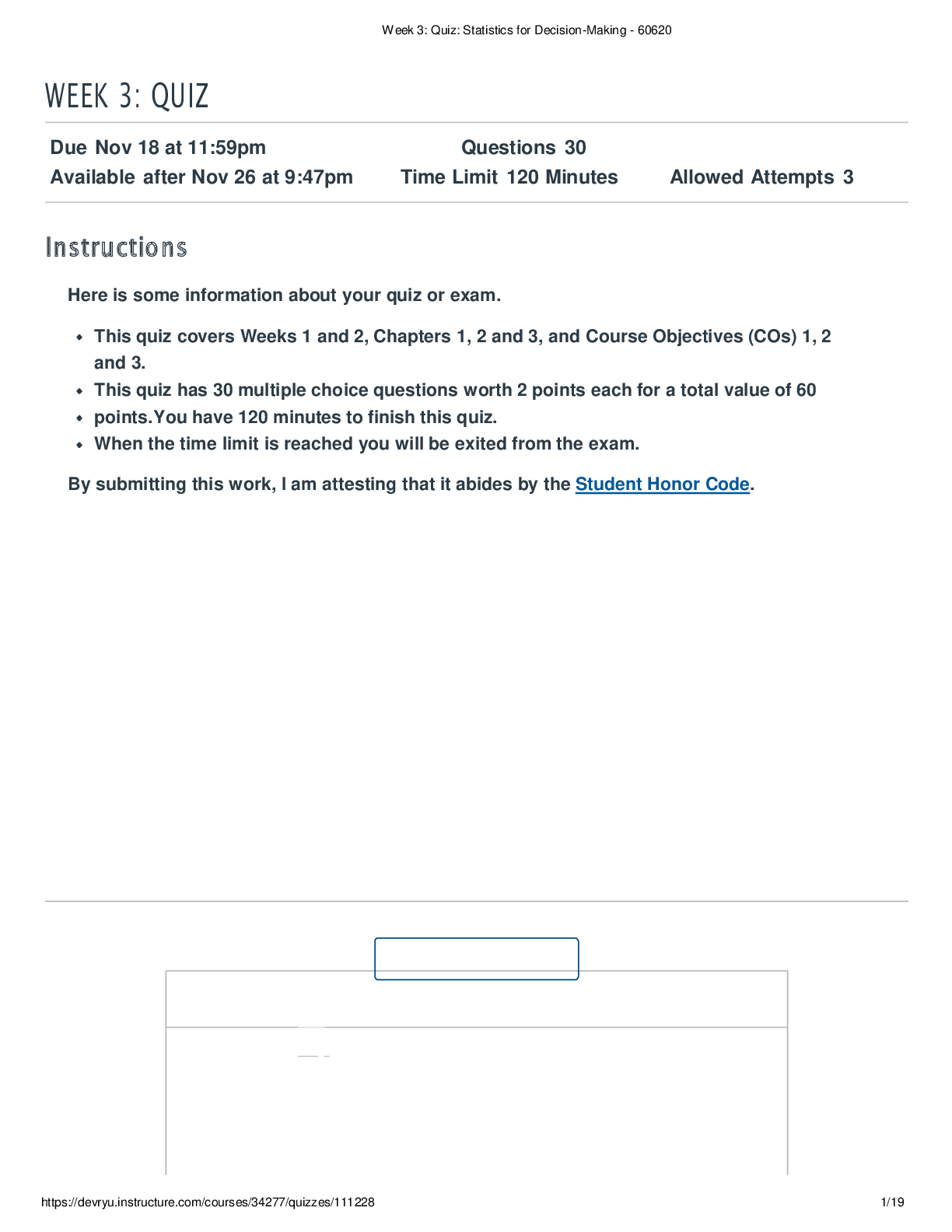

.png)











